


































AS INTERNATIONAL AIRLINE TRAVEL bounces back more strongly than expected from Covid, Africa has once again been left behind.
The African aviation industry has struggled to compete on the world stage with its share of airline traffic having fallen from around 2% to currently 1.8%despite having 20% of the world’s population. This is despite ICAO’s “No Country Left Behind” policy.
In an interview carried in this edition with the SACAA Director Ms Poppy Khoza, she explains what the No Country left Behind (NCLB) policy does. Ms Khoza says, “The concept is based on the principle that those countries that have consistently maintained critical safety or security elements ratings of above 80% must assist those who are struggling to be compliant within their respective regions or on the continent.”
Khoza points out that, “South Africa plays an integral role in assisting our neighbouring States. Some years ago, SACAA developed a Regional Cooperation Strategy, according to which technical assistance was offered to many countries in the SADC region. We are collaborating successfully with countries whose level of effective implementation is below the global average, and this collaboration is greatly recognised by these Member States and ICAO.
“There are many African countries who are performing very well, and, in this regard, I would also like to recognise the election of Nigeria and Egypt in Part II of the Governing Council, because of their contributions to the provision of facilities for international civil air navigation,” she says.
“Far more significant is that Equatorial Guinea, Ghana, Ethiopia, and Zimbabwe were elected to Part III of the ICAO Council, as States ensuring geographic representation. These were significant achievements for the countries, their respective regions, and the continent, as we all look at improving air connectivity, enhancing aviation safety and security, and also at contributing significantly to the socio-economic benefits for the Continent.”
Reacting to a question as to whether her appointment as President of the ICAO General Assembly was not in response to the NCLB policy, Ms Khoza pointed out that “Leadership and competence constitute the first priority in terms of determining who will be elected to Chair such strategic and important conferences and meetings. The complexity of issues requires more than the notion of the “no country left behind” as a measure to determine who will be elected.”
It is thus reassuring to note that many African countries and aviation leaders are rising to meet the challenge of the highest aviation standards. But there is still a huge gap to be bridged if Africa is to grow its miserable 1.8% share of the international airline market. Airlines must be set free from government control and allowed to compete in a liberalised Open Skies environment.
May I take this opportunity to wish all our readers and online followers a very happy and restive festive season and all the best for 2023.
there is still a huge gap to be bridged
THE FOLLOWING MORNING we went out to the airport again. The aircraft was sitting forlornly with its cowlings off and engine exposed. It was the first time I had been able to examine an aero-engine at close quarters. It looked a bit like a Volkswagen unit to me. How they expected a Volkswagen engine to pull us up all the way over those mountains was anyone’s guess, but it seemed to confirm beyond all reasonable doubt that this would definitely be the vessel which would, probably very violently, convey me across the Styx.
The pilot seemed to work as hard on the plane as the engineer and had acquired a similar set of grease stains. He didn’t fit my image of the dashing debonair Don Giovanni who had saved the world with a flick of a white silk scarf and a twist of his handlebar moustache during the Second World War. This pilot had dirt under his fingernails and sweat dripped from his short gingery hair over the freckles on the bridge of a nose which had obviously seen action on the rugby field. His forearms looked as though they had been tempered at a blacksmith’s forge.
As I sat and watched him work, I felt that I would prefer to meet my maker in the company of this tough nut rather than at the hands of some dilettante Deb’s Delight.

Time for our trip was running out and with it, the faint glimmer of a stay of execution began to grow in my mind. Then my appointment with the Reaper returned to the original schedule.
“Soon be ready,” the pilot said, as he helped the engineer put the cowlings back in place. He reached up and flipped open a small hatch in the top of the cowling. Pulling out the dip stick, he checked the quantity and replaced it. “She’s right,” he muttered and swung himself into the cockpit. “I’ll just give her a run to make sure.”
The door closed and the word “CLEAR!” came through the open window. The engineer stuck a thumb in the air and the propeller kicked round. Black smoke coughed out of the exhaust stack and was whipped away under the belly as the prop blurred and the engine
In Part 1 Hugh described how he had been convinced he would die in a plane crash on his first flight. Now, as a young man in New Guinea, he had had a stay of execution when the Cessna 185 would not start. The next day they tried again to fly up into the remote cloud-shrouded mountains.
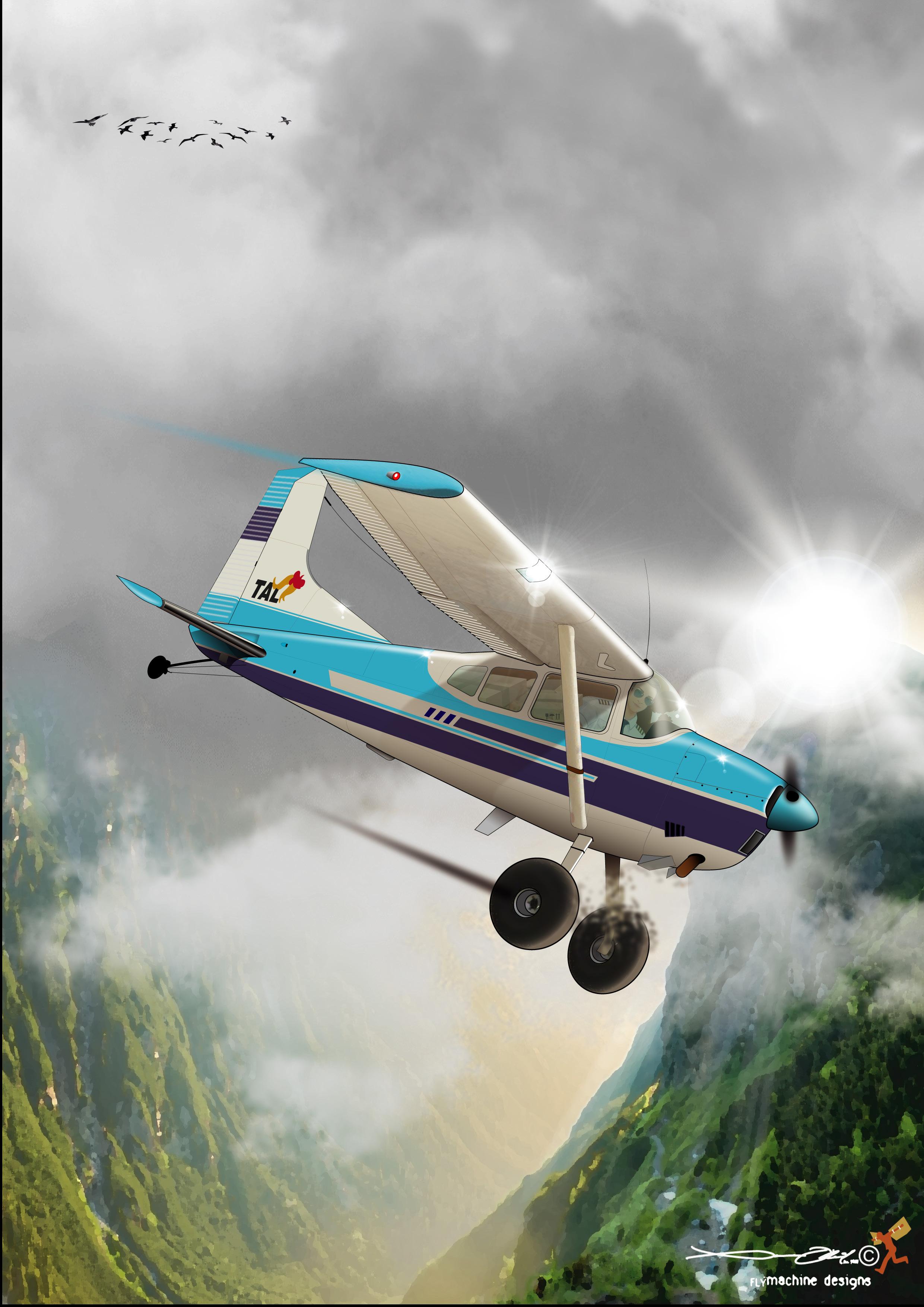
growled into life. Then silence returned, the propeller blades clacked to a stop and the aircraft door opened. The pilot jumped to the ground and glanced at his watch. “Hmm,” he said. “Going to be a bit tight. I’d better run over and do the flight plan. We know what the weather’s going to be doing!”
So saying, he strode over to the control tower. In a couple of minutes he came jogging back, holding a pink sheet of paper. “Let’s go, Mate. You ready?”
“Yes.” I said, “I’m ready. Where’s Mrs Kibikibi?”
“Dunno, mate. Must’ve chickened out.”
“Oh,” I said, wondering if I should have done the same. No, I decided. I must have my appointment with Destiny, and walked towards the Cessna where the pilot was holding the right hand door open for me. I knew the feeling of the condemned man walking to the gallows. I was shaking as I climbed awkwardly into the co-pilot’s seat. Yesterday’s boxes filled the back of the cabin, secured under a cargo net. The pilot showed me how to don the full harness.
finishing the ritual by hauling the flattened steering wheel back and twisting it, so that the one on my side banged into my chest. “Beg pardon.” He grinned and pushed it forward again. Then he reached down and pulled up a lever between the seats, while pressing the button in at its end. I assumed that he was testing the hand brake.
“Flaps,” he said, indicating that I should look out of my window. The back of the wing slid out and down. “We’ll be using those to get us in the air quicker on takeoff.”
He turned a key in the instrument panel and pressed a button. A propeller blade flopped past the windscreen, almost immediately followed by another and another, until, with a rattling shudder the propeller blades disappeared and the engine settled into a smooth rumble.
“There,” he said, patting the release buckle. “That should keep you out of trouble.” I was now trussed for my trip to look beyond the horizon of life. “If you want to release it, you just twist the buckle here.” He demonstrated and the webbing fell away. “Okay, let’s see if you can put it back together again.” I retrussed myself and faced the wall of strange-looking instruments.
He jumped into the pilot’s seat and strapped himself in. He then put his headset on and handed me the other one. “You have to eat the mike, otherwise I can’t hear you,” he said, pushing the little microphone against my mouth. “Press the INT button if you want to talk to me and the PTT button if you want to talk to the rest of the world, which you don’t.”
He ran his fingers expertly over the various controls,
The pilot switched on the radio and called the tower. The tower came back with taxi instructions and a garble of letters and words that made the pilot fiddle with the altimeter. We moved out of the parking area and stopped short of the beginning of the runway. I was trying to work out how he had steered the thing without moving the steering wheel. He applied the real parking brake this time, by pressing the pedals with his toes and hauling on a lever below the dashboard. Then he went through a well-practiced litany of engine checks and I was duly impressed by his smooth familiarity and expertise.
He talked briefly to the controller and we moved confidently into position on the runway. He didn’t seem to be aware of the ravens of death fluttering around the periphery. Maybe he didn’t know that this was to be the first and last time that I would leave the surface of Mother Earth.
The pilot gently pushed the large knobs, like organ stops, into the lower panel and the engine note rose to a trembling crescendo. Suddenly, with a lurch, I was forced into the back of my seat and we roared down the runway. There was obviously something a
bit bigger than a little Volkswagen engine under the bonnet of this beast!
Before I realised what was happening, the ground dropped away and a palm fringed coastline rose into view. We turned inland and the houses of Madang sped past under us. I tried unsuccessfully to identify streets and buildings but dense forests soon blotted out any evidence of human influence on the flat countryside which moved under our aircraft.
A mighty and untamed river suddenly swelled against the forest below us and high tufts of cloud began to jostle together, forcing us to dodge and weave between their grey entrails. It was fascinating and intimidating at the same time. Our little craft bucked as we skimmed a wing through the petticoats of one particularly impressive column of white cauliflower.
My stomach muscles tensed in reaction to the sheer mindless power of the weather. I was rapidly coming to realise that this flying game was not really a game at all. Or if it was, then it was completely one-sided. Pitting a pathetic little aluminium craft against the majestic grandeur of these steaming giants seemed to be the height of folly.
Soon I noticed that the ground was no longer flat. It rose on either side of us until it touched the clouds. We were entering a wide valley dotted with tiny dwellings roofed with pandanus palm leaves and surrounded by banana trees and high palisades of split timber. The clouds had formed into a solid and threatening overcast.
“Do you know which one is the Simbai valley?”
The pilot looked at me as if asking for advice. He pointed out of the windscreen and I could make out the entrances to a number of deeply forested valleys up ahead of us. Their steep sides disappeared into rain heavy clouds. A cold shiver of realisation crept into my bowels.
“Haven’t you been here before?”
“Once,” he said with a grin. “And you?”
“Never.” I replied. “I’ve never even been in an aeroplane before.”
“You’re joking?”
“No. This is the first time.”
“The blind leading the blind!”
We were becoming quite intimate with the local population now, forced into this relationship by the low altitude of the clouds. I could see almost naked figures running and pointing as we flashed by. These were the ones who would pick through the pathetic remains after my demise. A furious pig charged at a fence in an effort to attack us. Then the jaws of a valley opened up on our right and, looking through into its gullet, I could vaguely make out the yellow stain where a large portion of the valley wall had fallen into the river, which wriggled like a live snake around the obstruction. A landslide. This must be the Simbai Valley.
“I believe that could be the Simbai Valley,” I said, pointing tentatively out of the right side of the windscreen. “Con Hatters told me they’d had a big landslide in the Simbai Valley, a couple of days ago. Quite a lot of people killed and missing. That looks like a landslide to me.”
“Yeah, I heard about it. But are you sure that’s the one?”
“No, I can’t be sure. I’ve never been here before.”
“Well, you know what’s going to happen if it’s the wrong one, don’t you?”
the sheer mindless power of the weather
“Yes, I am all too well aware.”
“Okay, well just so long as you’re happy. Here we go!”
And, so saying, he swung the little plane into the dark mouth with its writhing river. This was it. My whole body tensed in preparation for the final debacle.
We seemed to stick unpleasantly close to the wall of rain forest which reached out for us on my side of the plane. The pilot, noticing my apprehension, grinned and said, “We stick to the sides of the valley. It’ll give us a better chance to turn around if this is the wrong one.”
I wondered how that first impact would feel. The tearing of limbs. The crack of a skull going through the instrument panel. Maybe, hopefully, I would lose consciousness as we hit the trees. Then, suddenly we swerved around a hill and the ordered lines of a grass runway appeared above the cowling.
“There she is!” shouted the pilot, and before I had time to prepare myself, he hauled on the big floor lever, played with the organ stops and we were on the ground.
It was raining. I had survived. The weather closed in and a rumble of thunder echoed around the cloud-shrouded peaks as if they were infuriated at having been cheated out of another wreck. The pilot would spend the night in Simbai, rather than provoke the implacable wrath of the mountains. For some unknown reason, Fate had decided that I was still alive.
It wasn’t until after the third glass of a delicious Yalumba Port that evening, by a fire, in the relaxed luxury of the Patrol Officer’s house that the pilot owned up. He had been landing at Simbai twice a week for over a year now!
Van Der Merwe Johann Stellenbosch 021 887 0305 johann.vdmerwe@medicross.co.za ✗ ✗

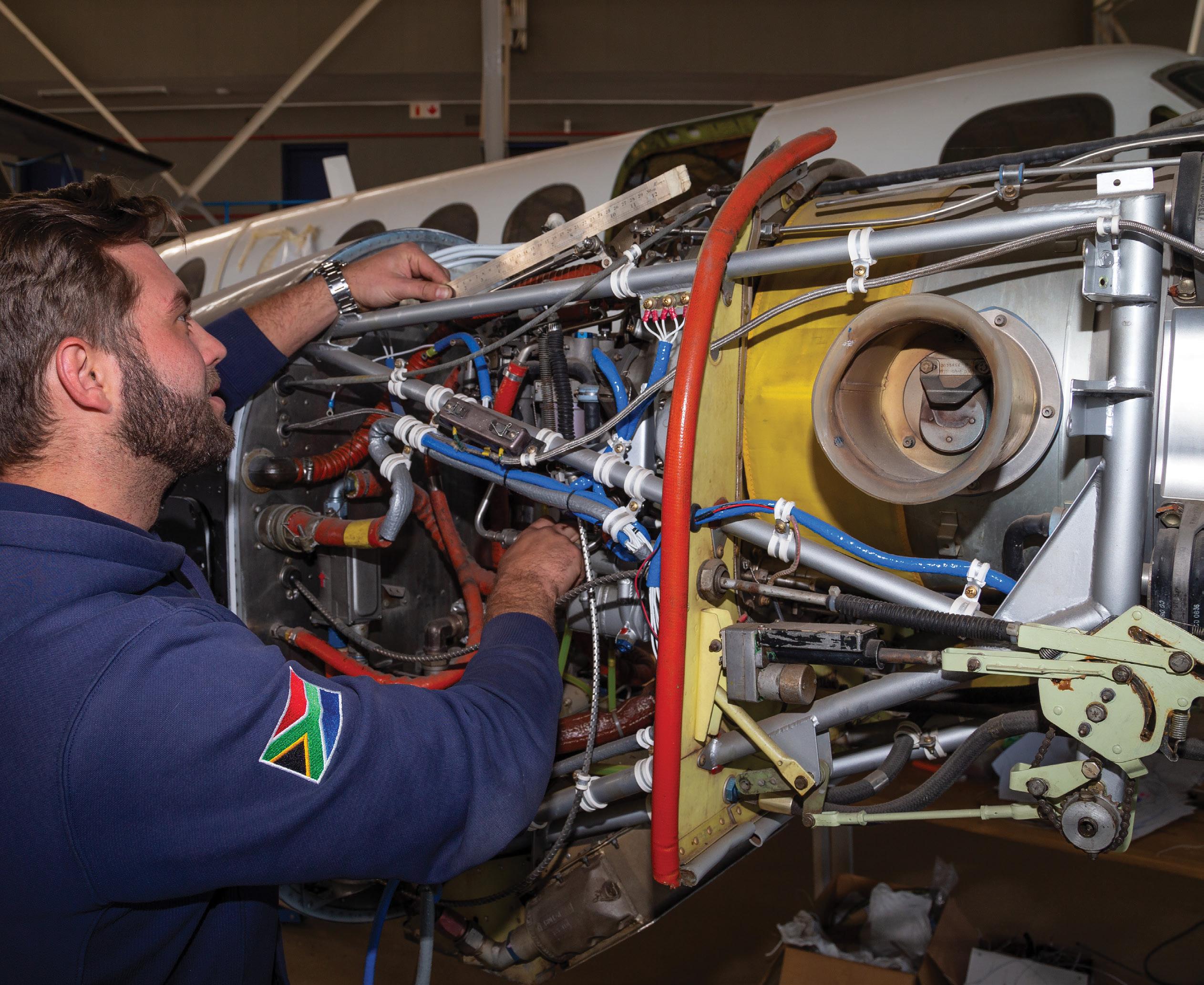


PART 1 SHOWED HOW defence of the country’s airspace requires fighter aircraft. There is no alternative.
While ground-based air defence systems can provide some level of protection, South Africa’s territory is so vast that an impossibly large number of theatre-scale air defence systems, essentially in the same class as the Patriot, SAMP/T, or S-300/S-400, would be needed all over the country.
And given that those systems cost about US$400 million per battery and US$2-6 million per missile, they’re substantially costlier than one or two squadrons of fighters.
average seven years to train up new fighter pilots to just a basic level of competence, re-establishing this capability once lost would realistically take no less than ten years and probably around fifteen for full proficiency. That’s far too slow to respond to any looming threat. Preserving the capability on an ongoing basis is also not that costly in relative terms, and certainly cheaper than the potential damage that could be caused by needing the capability and not having it.
It was also clear that a fighter aircraft capability could not be abandoned and then established only when absolutely needed, because it takes years and years and immense expense to build one from scratch. With an average lead time of three to five years to deliver fighter aircraft from the date they’re ordered and it taking on
Therefore fighter aircraft were listed as a basic requirement in all of the four options proposed to policy makers, each of which had a different balance of cost, capabilities, and numbers. Some proposed both light fighters and medium fighters (such as Typhoons or Rafales), and in fact the option eventually chosen by Cabinet specified 16 light fighters and 32 twin-engined medium fighters (with subsequent budget cuts however a compromise was made to abandon the medium fighter procurement
Part 1 this column addressed the process behind determining what sort of defence capability was need in terms of South Africa’s constitution and in terms of the likely war scenarios it may face.
and instead look for more capable single engined light fighters).
These justifications and findings were summarised in the 1998 Defence Review as the following, for support to land forces, for air defence, and for support to naval forces:
“Fighters are the main means of ensuring a favourable air situation over an area of operations, thereby preventing enemy air operations and enabling aerial support to own ground forces. Their employment in air defence thus has important benefits in landward defence. Direct fighter support includes fire support, interdiction of the battlefield and enemy rear lines of communication. Both medium and light fighters are included in Option 1 (32 and 16 aircraft respectively). Light fighters can, however, only be used in a relatively benign air defence environment.
“The active component of defensive counter air measures include the early detection and warning of enemy air activity, ground- or shipboard-defence by means of gun or missile systems, and the use of
fighter aircraft to intercept enemy aircraft. The passive component comprises the hardening of potential targets, the dispersion of assets, camouflage, damage repair capabilities, and so forth. Offensive counter air measures consist of direct attacks on enemy air assets including bases, aircraft, air defence systems, radars and command and control centres to neutralise enemy air capabilities. As detailed in Chapter 2, offensive action at an operational level in response to an enemy attack would not violate South Africa’s primarily defensive posture. Offensive counter air measures are thus not excluded from the range of possible air defence actions.
“Obsolescence and defence cutbacks have led to a reduction in medium fighter numbers from 89 in 1989 to 51 aircraft. The F1s are to be phased out in 1999 subject to annual review, while the Cheetah C will stay in service until 2012. The Option 1 requirement is for 32 medium multi-role fighters.”
Fighters provide rapid reaction to a naval threat and can substantially complement naval fire power, thereby compounding the self-defence problem of the

enemy. While Option 1 makes no special provision for this role, multi-role fighters dedicated primarily to air and landward defence can be employed in this capacity.
When South Africa’s Cabinet at the time formally adopted both the 1996 White Paper and the 1998 Defence Review, it formally authorised the defence force to preserve a fighter capability and to move forward with an acquisition programme to replace the Cheetah C and D then in service in order to ensure that the country had a viable fighter capability into the future. That’s the basis on which the South African Air Force established its fighter acquisition programmes (first Project Kambro, then Project Ukhozi) and went on to acquire 26 Gripen Cs and Ds in the 1999 Strategic Defence Procurement Package, aka the ‘Arms Deal’.

So rather than being something decided on a whim, or being done for corrupt reasons, South Africa’s fighter capability exists because of an extremely thorough and serious military analysis that was later repeated and confirmed for the 2015 Defence Review. In fact, as climate change, geopolitical instability and other factors have begun having a greater impact, the need for fighter aircraft has become even more urgent.
The basic need was also shown extremely clearly in March 2013, when four Gripens were hurriedly dispatched to Kinshasa to provide air support for lightly armed South African troops in Bangui who had come under severe attack by a much larger group of rebel forces.
No other support platform, not even the two Rooivalks dispatched as well, was able to be nearby and available as quickly as the Gripens. While difficult to know for
certain, there are some indications that the presence of the aircraft dissuaded the rebel forces from further attacks, saving lives. If we still had an aerial refuelling capability that deployment could have been even faster, too.
It’s time for the quality of the public defence debate in South Africa on topics like this to become more serious, more aware of the analyses and planning that has led to this point, and more willing to accept that any defence planning inherently requires compromises between cost and capabilities.
South Africa came extremely close to losing its fighter capability over the past year, with the Gripens

grounded, but it’s not out of the woods yet. National Treasury still allocates a woefully insufficient budget for the Air Force’s combat aircraft capability and if nothing changes it will become impossible to operate any combat aircraft at all within the next five to ten years. This should be provoking serious alarm from the public, civil society, media, and opposition, and top level interventions to prevent it from occurring. But so badly has the situation deteriorated, that none of that is happening.
South Africa is sleepwalking into a collapse of its strategic capabilities and sovereignty.
McDermid continues her stories of Iris McCallum’s flying exploits.
ASLAM KHAN WAS the financial director of Aircraft Leasing Services (ALS). He had built up his vast network of contacts whilst in the Kenyan Air Force and had decided to start the family business after identifying a huge gap in the Miraa Khat transport business.
Aslam is also a well-known and highly respected East African rally driver. He started rallying at the tender age of 21 and has won the Kenya National Rally Championships three times. The combination of his fearless nature and sharp business acumen made him the ideal candidate to run an operation that was highly competitive and fraught with risks.
not to grow them, thousands of Kenyans depended on the trade of this plant for their livelihood. In the early 1990s many businesses sprang up in Kenya to service the ever-expanding and seemingly endless demand for this herbaceous stimulant.
I had been flying Miraa for some time now and I got to know many of the Somalis who were involved in selling the product. They had nicknamed me Halima, an Arabic word which meant ‘forbearing, gentle, mild-mannered and generous.’
Thanks to the healthy demand for Miraa Khat in Somalia, where it was legal to chew the leaves – but
The synergy between ALS and myself was good; I bought my Somali contacts to them to charter their aeroplanes, and in return, I got to fly the Miraa to Somalia and get paid handsomely in U$D.
Laura
“Iris, Ashraf mentioned that you may be interested in flying for us; we need pilots with your experience. My brother regards you as part of the family, so it would be great to have you on board.”
There was complete anarchy in Somalia
Flying out of Wilson Airport into a bordering country meant always filing a flight plan. We entered Mogadishu as the destination, however, we would in fact fly 60 miles northwest of the capital to a disused military airstrip called Baledogle located in the district of Wanlaweyn. Due to its remoteness, we could land, unload the aircraft and be airborne within an hour, without being harassed by officials looking for bribes.
For the sake of my license renewals, I had to log a legitimate airfield. My Instrument rating had to be renewed every 13 months; this was to ensure that the flights occurred over all seasons and in different weather conditions.
On 10 April 1992 I was scheduled to fly 5Y-AYY, one of ALS’s three Cessna T310Rs, whilst Gulu, Ashraf’s brother-in-law, was assigned to 5Y-BAF and another pilot to 5Y-TNT.
There was complete anarchy in Somalia in those days, and the only law that was upheld was amongst the clans. It was therefore safer to fly in a group whenever possible.
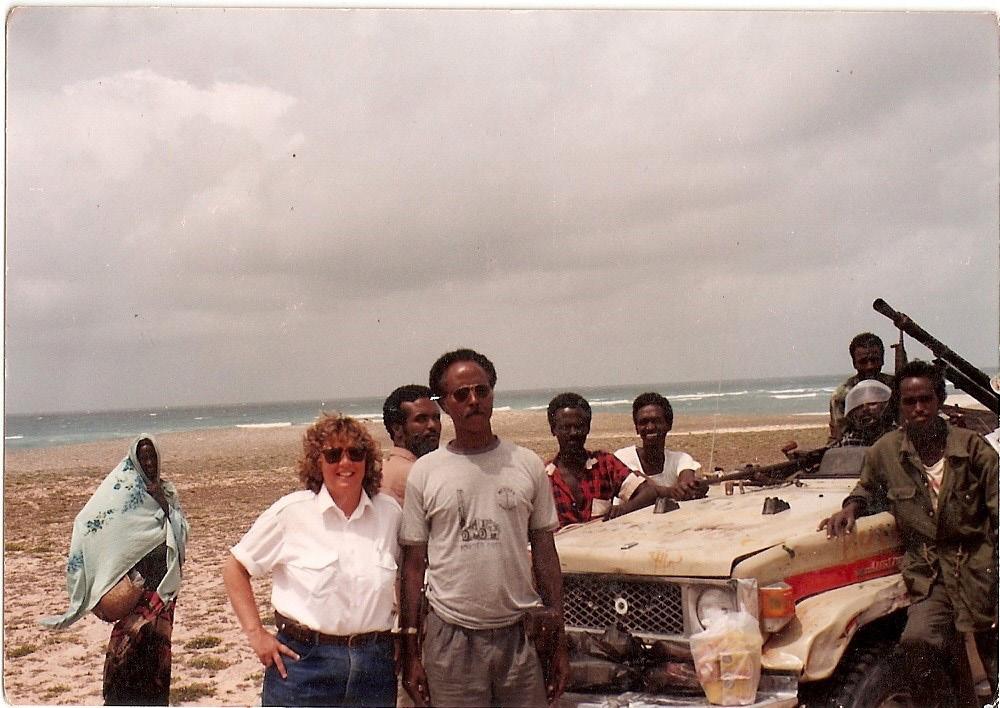
We had to trust ‘our’ Somali traders completely, who in turn relied on their contacts in Somalia to keep us, the aircraft, and most importantly the Miraa safe from marauding bandits (shufti’s).
To keep my CFII current, I travelled to the USA, my last check having recently been done at an airfield in Houston, Texas.
I was at the hangar before dawn, my hands running over the familiar airframe, never tiring of the 310’s
“I KILL YOU!” Ahmed screamed at me.
sleek curves. Checks done, I taxied to the fuel bay, filling the main and wing tip tanks with Avgas, but only half-filling the auxiliary tanks to be able to carry more Miraa.
I heard the familiar rumble of the Land Cruisers as they began arriving from their long journeys from Nanyuki and Meru. The pickups were heavily laden with Miraa that had been picked through the night on the slopes of the highland mountains by the local women. The drivers left at around 02h00; chewing the herb they transported to keep them awake.
“Inshallah Hussein. Alpha-Yankee-Yankee is ready to load.”
To maximise the packing space, the rear passenger seats from the Cessna T310R had been removed. The aircraft had a big nose baggage compartment that could hold a lot of luggage, as well as wing lockers on both sides. We would fill the nose first, the wing lockers next and the body cavity last.
My Somali trader, Hussein, joined me at the plane. “As Salam Alaykom Iris, we have a big load today. We may need to do two runs”.
The weight of the herb changed according to the season. In the dry season, the bales weighed 5-6 kg, whereas in the wet season they could weigh as much as 8 kg.

The maximum takeoff weight of the aircraft is 2500kg, but we would typically push the load 15% above that.
“Naseem, I know you put an extra bale in,” I admonished one of the packers. He shrunk back from my glare, holding up the palms of his hands in supplication.
too far aft. The long nose of the C310R made it ideally suited for this purpose.
“Sorry Halima, me I was not thinking.”
Though I may have been patient and mild-mannered, everyone knew that I was no pushover. I rarely lost my temper, but when I did it was epic.
The sellers wanted to squeeze as much of the product as they could into every available square inch. They didn’t understand (and generally didn’t care) about MTOW and how it affected the performance of the plane.
Thanks to turbochargers, each engine was producing 285 horsepower; this mean that the 310 had a better power to weight ratio than many larger twin-engine aircraft, such as the very popular C402, and when fully laden, the Vref landing speed was critical to within 4 knots.
The distribution of the weight was critical, and I never allowed the plane to be packed without overseeing the process. I inevitably had to manipulate the weight to optimise the centre of gravity, ensuring that it was not
We took off from Wilson Airport just as the first blush of red smeared the eastern horizon. I have lifted my
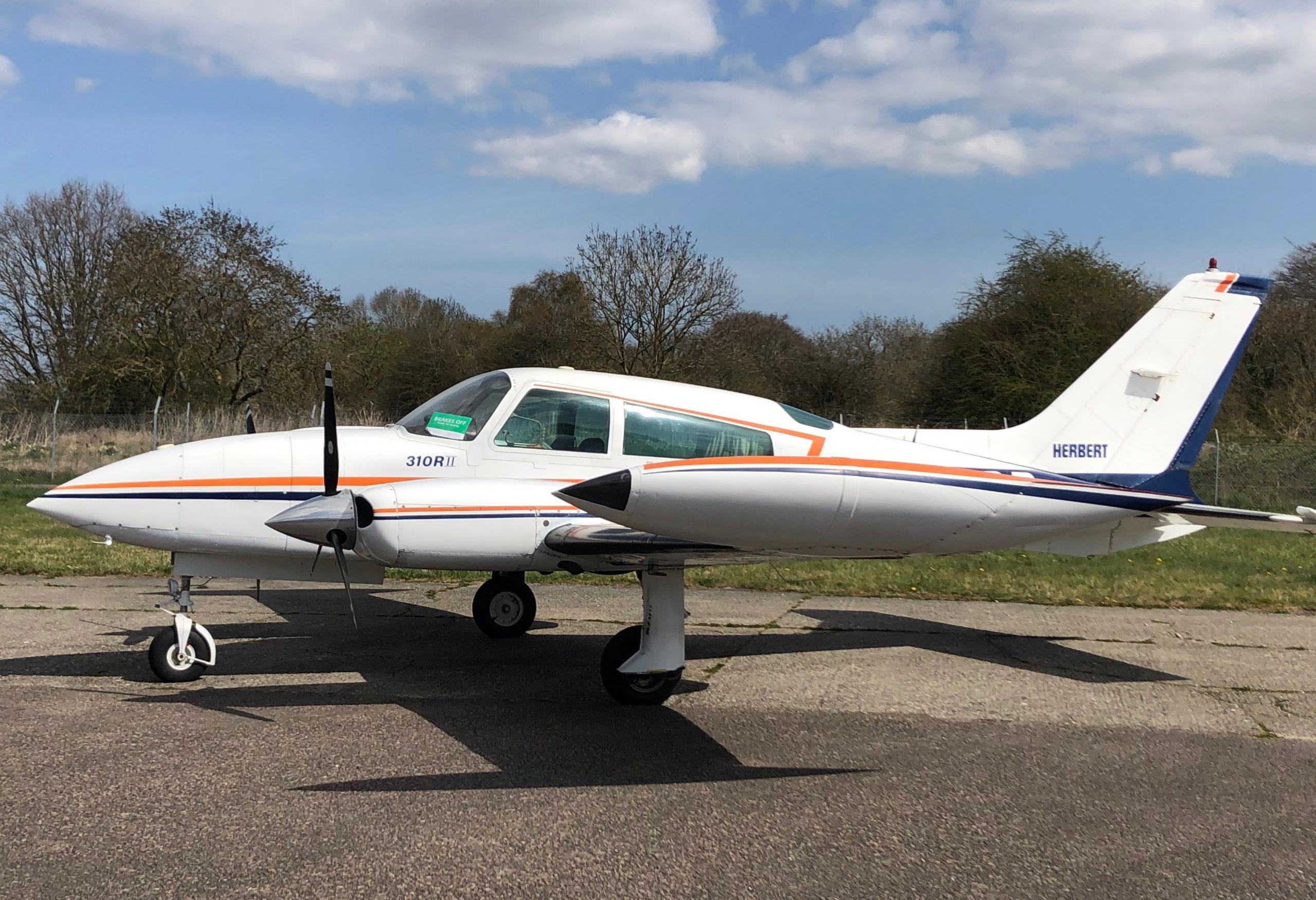
plane from Wilson airport for thousands of flights and I have never felt her wheels glide from the earth into the air without knowing the uncertainty and the exhilaration of first-born adventure.
“I KILL YOU!” Ahmed screamed at me.
I exchanged a meaningful look with Hussein, and then addressed Ahmed. “I will take you back, but first you need to sit down and calm down.”
Three hours later we were overhead Baledogle. I flew the length of the strip, making sure it was clear of goats and donkeys.
I Landed and taxied to where my contacts were waiting for me on the northern end of the strip. As the Miraa was being offloaded, Ali, who manned the hand-pumped bowser, topped the C310R up with 200 litres of Avgas.
I had a plan in mind and was counting on Ahmed’s ignorance of aviation for it to work.
I started the plane and taxied to the parking outside the immigration area, turning the plane around so that the tail was facing the building.
Whilst this was going on, Hussein would disappear, reappearing 30 minutes later with whatever passengers required a lift to Kenya. They were mostly refugees who were fleeing their war-torn country in search of greener pastures. This process went off without a hitch most of the time, but there was one occasion when the Kenyan authorities refused entrance to a particular young man whom I will call Ahmed.
After landing at Wilson, Hussein went off to customs with Ahmed’s passport, only to return ten minutes later informing him that there appeared to be a problem and that he was to go with him to the authorities.
Ahmed refused and demanded that I take him back to Somalia immediately. A heated exchange ensued in Arabic between the two men, resulting in Ahmed becoming hysterical.
I proceeded with my run-ups, blasting dust and debris through the office entrance. Within seconds an indignant security guard came running out to see who was being an idiot.
When the guard was close enough, I shouted to him in Swahili, telling him that the passenger had threatened to kill me.
During the commotion, Hussein had opened the door, and three security guards swarmed in with guns trained at Ahmed. They promptly hand-cuffed him, manhandling him out of the aircraft.
I later heard that Ahmed had been detained for three days. This appeared to have tempered him. Gulu had the task of flying him back to Somalia and gleefully reported that Ahmed was as meek as a lamb.
They promptly handcuffed him, manhandling him out of the aircraft.
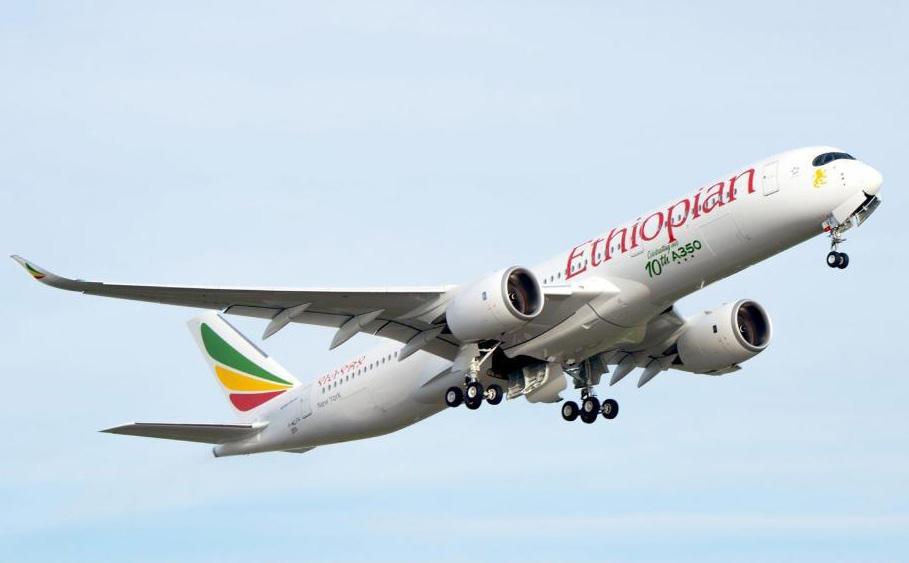
THE AIRLINE ALREADY operates the largest fleet and destination network in Africa. “In vision 2035, we have aimed to nearly double the number of destinations that we will be flying by increasing the number of destinations from 131 today to 207 and to cover this expansion, we have planned again to double the number of aircraft in our fleet from 140 to 271,” Ethiopian Airlines Group
CEO, Mesfin Tasew, who took up the role in March 2022, told state media, Ethiopian News Agency (ENA).
The airline also seeks to carry 65 million passengers, three million tons of cargo and generate $25 billion dollars in revenue by 2035, Tasew added.
Ethiopian Airlines has ambitious growth goals for 2035.
Ethiopian Airlines aims to double its fleet and destination network with its ambitious ‘Vision 2035’ strategy. largest fleet
with Zimbabwe were fed up with the increase of criminal activity that impacted them and had called on me to do some patrolling of their game reserve fences.
Members of the South African National Defence Force (SANDF) and the South African Police Service (SAPS) had been instructed to stop co-operating with AfriForum’s border security structures in Musina, Limpopo. “It is very clear that political interference is once again derailing successful efforts by committed citizens to work together with the SAPS and military to curb crime,” said the head of a private Limpopo security firm.
are) being stolen and breached to move rustled cattle, stolen in Zimbabwe, herded at night over the river, through game farms and getting their throats cut, slaughtered and carcasses loaded into vehicles for sale in townships. Their heads, skins and offal are the only grizzly reminders.
Cigarette smugglers were coming through the farms in gangs of 50 and dumping all the packaging next to pick up points, littering the bush with hangars full of rubbish. Copper cables were being pulled out of the ground and transformers destroyed and gangs of pirates lurked to rob the robbers and smugglers.
It’s never a good thing to have a game reserve with buffalo, lions, elephant and other game, no longer safely contained within electrified game fences. The iron droppers supporting game fences were (and still
A hyena is the name given to a person, who having gathered a required number of undocumented travellers, goods or other contraband, would head for any one of their chosen points along the river to take them across. The hyena man is also known in his community for executing a ‘cleansing practice’, fisi,
will let me go
The Covid lockdown had opened a whole new can of worms and the curfew was undoubtedly benefitting criminals.
in which he is invited and rewarded by adults to sleep with new widows, barren women, women who just had an abortion or with young girls undergoing rites of passage to adulthood.
hyenas are needed and respected, concerning the burial of the dead. The belief is that whoever touches a corpse risks defilement. Only known hyenas can execute the task of handing over a dead person from the living to their ancestors.
The hyena sleeps with such women (and girls) as a way of driving away bad luck or potential calamity believed to hang over the community. Adolescent girls are routinely rounded up into a camp every year, where they are taught their pending duties as wives, not least how to please men sexually. ‘Sexual cleansing’ with the hyena represents the final stage of the ritual, which is arranged willingly by the parents. (see: https:// en.wikipedia.org/wiki/Sexual_rites_of_passage )
During non-Covid times, and in the present, private transporters, or umalayitsha, are Zimbabweans who use their own cars, small trucks and minibus vans to transport people, goods, money and various kinds of contraband along the Johannesburg–Bulawayo motorway. The Johannesburg–Bulawayo motorway is a 900-kilometre road transportation corridor connecting South Africa to the interior through south-western Zimbabwe.
In some African cultures the extended services of
It is well documented that at the Beitbridge border,
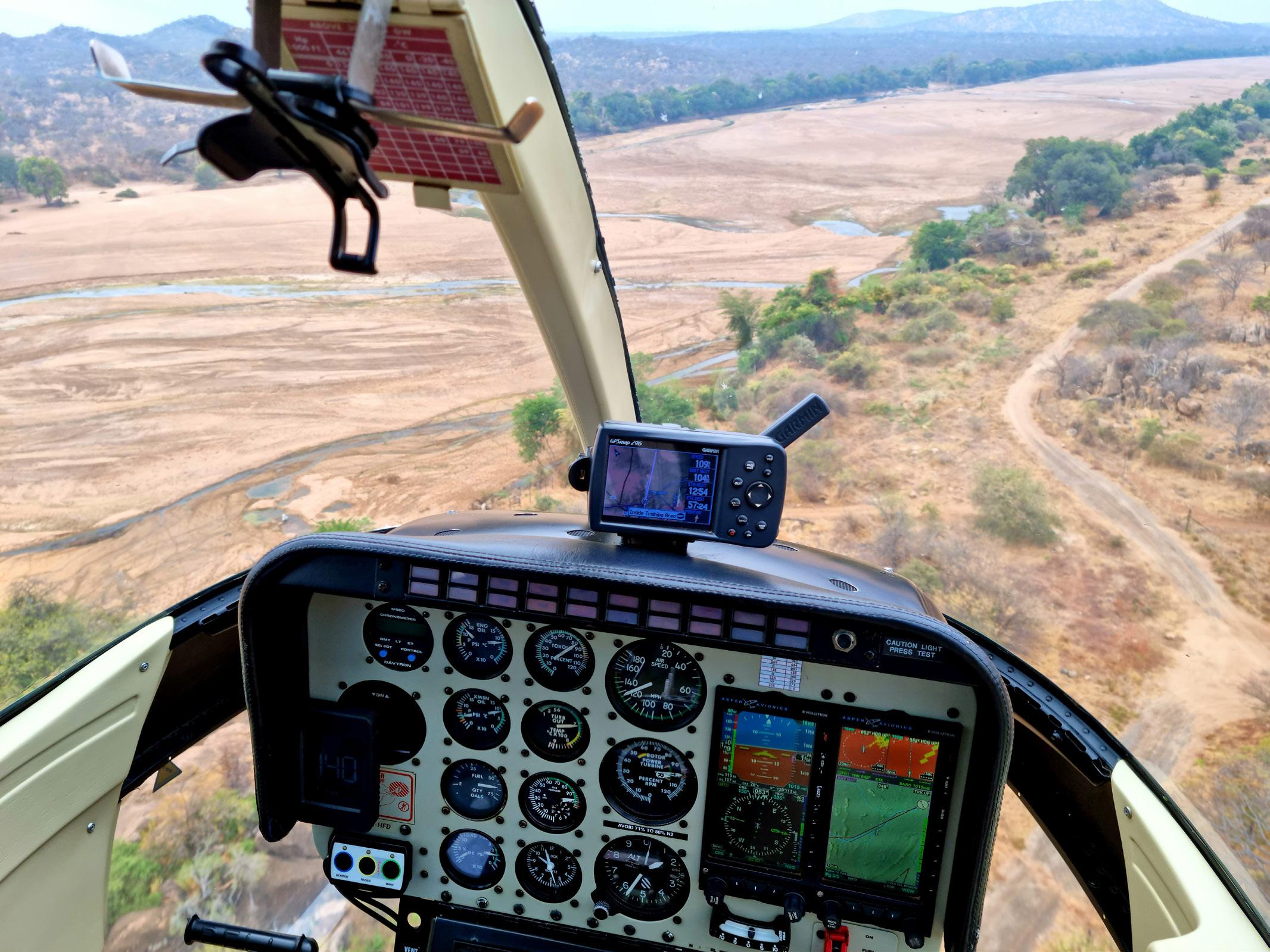
immigration, customs, police and officers working in the labour ministry and other relevant government departments act in ways that deliberately seek to cultivate or sustain such a system. Promising to expedite the border crossing process, these practices have encouraged lucrative social economies in which hyenas participate actively in assisting people and their goods to cross, and from which they derive a variety of benefits.
come to expect that my friends in the force will let me go as long as my colleagues outside can guarantee that they are working something out.”
After learning so much regarding the level and depth of all the corruption, I seriously doubted how my presence would help, and in fact worried about my own safety. This was highlighted to me in an almost –but not quite – amusing incident.
The scale of the problem defies imagination - in just two months of the lockdown; April and May, more than 5,500 undocumented people were apprehended along the borders with Zimbabwe and Mozambique. In addition, drugs, firearms, livestock and other contraband were confiscated. In one incident, 50kg of copper was confiscated. And that was the tip of the iceberg.
We had taken off from our safe haven base and were flying along the Limpopo River looking for the tracks of stolen vehicles in the river bed. In the near distance
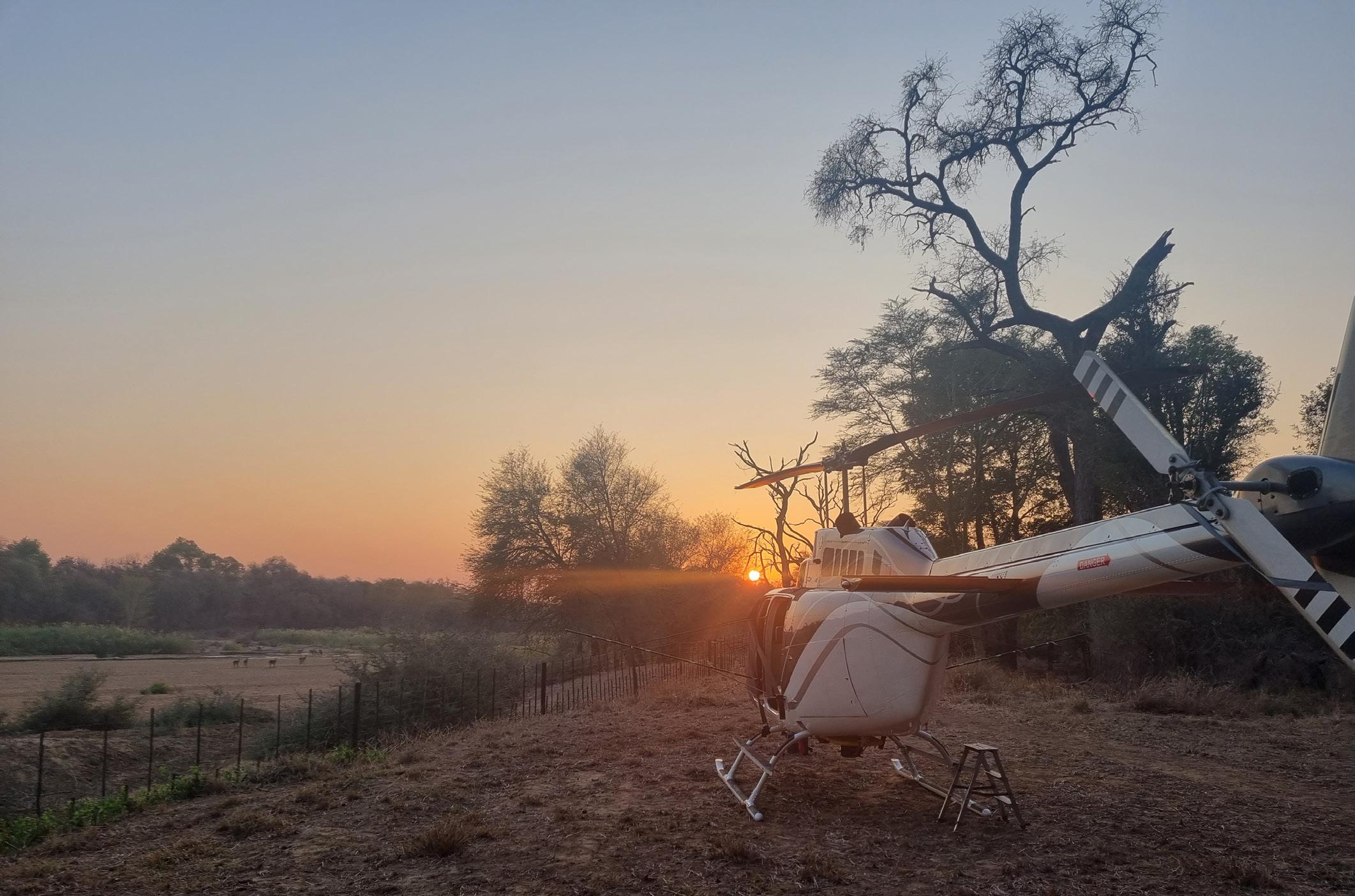
One of the people we captured who was involved with night time smuggling, had this to say: “Because of my many arrests, while I am at the police station, I have
I noticed a wisp of smoke rising between the tall trees on the Zimbabwe side of the river. As we got closer it became evident that this was a large smuggling camp, set up with a couple of tents, a covered cooking area, three huge piles of unknown goods covered well under black plastic sheeting, a couple of minibus taxis and a handful of well-dressed people.
But what caught my eyes most, was the silver-grey double cab bakkie stuck in the middle of the river.

doors off for better visibility and as a means of air conditioning, not having that luxury, all the while thinking that surely the sudden presence of a helicopter, having discovered such obvious signs of smuggling, would in the very least invoke some form of panic from those below. But no.

My ego was immediately shattered when three men casually walked out into the open below us, two of them wielding AK47’s slung over their shoulders, and all three casually looked up at us and in a very relaxed manner, proceeded to take pictures of us with their cell phones. I smiled, pulled away and we all wondered which government official was going to receive some pretty pictures of us, no doubt with a message along the lines of, “We are paying you for protection, so what is this helicopter doing?”
I admit that for quite a while I also had thoughts that I could expect a call from someone with a warning. And I’m still wondering.
Criss-crossing the wide expanse of sand were countless tracks from both humans and donkey carts. On the SA side of the river was another small camp hidden between the trees, a couple of tents and a minibus. On the Zimbabwe side there was an old yellow bulldozer in a clearing and it was evident that the bulldozer had made a raised ford-way across the river, as well as a freshly bulldozed road through the bush, disappearing into the distance. I decided to hover above the camp on the Zimbabwe side to take some photos and to look for anything of interest. We are flying with the
GL: Congratulations on your appointment as President of the ICAO General Assembly. How significant is this accomplishment? A) To you personally and B) For African aviation?
PK: Thank you very much. Personally, this was a humbling experience. The key nomination by the Czech Republic on behalf of the European countries was a huge honour and the unanimous election by all Member States is an experience I will never forget.
I must also acknowledge our government for driving the transformation programme with no apology, because had the government not been so progressive in gender equity initiatives, there would not have been a female DCA, and I would not have been recognised by ICAO and its Member States. I have no other option but to recognise God’s hand in all of it, and I am super grateful that He carried me through it all with distinction, and for that I am forever indebted to Him.
This election comes after I had served as one of the four Vice Presidents elected in the 40th Assembly of 2019. I must also add that prior to these responsibilities, I was elected, after being nominated by the USA and supported by all States, to chair the Facilitation Stream of the ICAO’s High-Level Conference on COVID-19 in October 2021. Prior to that I had also served for two
terms as the Chair of the Aviation Security Panel. All these responsibilities that I shouldered were building blocks towards this election.
Many people may not be aware of this, but the previous President of the ICAO Council was a Nigerian national, Dr Olumuyiwa Benard Aliu. Africa is making its voice heard and my appointment is just a step in the right direction for the Continent, and also speaks volumes regarding the talent and skills of Africans.
GL: Tell us about your background - when did you first imagine you could be A) The head of the SACAA? B) The President of the ICAO General Assembly?
It is common knowledge that I was born and bred in Sibongile, a location in Dundee on the north of KwaZulu-Natal. I was introduced to aviation whilst studying towards a qualification in Travel and Tourism at the Natal Technikon (now the Durban University of Technology).
My first job was with the South African flag carrier, South African Airways (SAA) as a customer service agent, where I eventually grew within the ranks
and left SAA at management level. I then joined the South African Civil Aviation Authority in senior management, where I progressed through the ranks and ended up to where I am today.
What attracted me to civil aviation, without knowing much about the industry, considering the history of our country, was the possibility to travel the world. Little did I know that civil aviation is, in fact, such a large, complex and multi-faceted field.
The global reach and impact of aviation activities exposed me to a brand-new world and honestly, the day the Board and Ministry approached me to temporarily head the SACAA, I was apprehensive. However, true to my nature, I had enough experience in the industry and I am not one to shy away from a challenge, and as they say, the rest is history.
The appointment to chair the single most critical global meeting where the future of global aviation is deliberated was intimidating at first, but I believed strongly that my career in the sector as well as the ICAO meetings I chaired as indicated earlier, prepared me for that moment. This particular meeting was so
GL: Is your appointment a recognition of what you have achieved with the SACAA?
I would like to believe that it is two-fold. Firstly, it is probably due to organisational successes, but also the role I have played in representing South Africa in the structures of ICAO over a number of years. I believe that ICAO and its Member States must have been convinced that I have the capacity to navigate complex discussions successfully, and with outcomes that are in the best interests of the organisation and the global aviation industry, striking the right balance on complex issues.
As an organisation, we have done a lot, considering the amazing milestones that the organisation has achieved over the years. Our international ratings on aviation safety and security with ICAO have increased significantly, which places South Africa among the best-performing countries in this regard. The SACAA

has reported nine clean audits in the last 10 years from the office of the Auditor-General. Just recently we retained our US-Federal Aviation Administration (FAA) Category 1 status.
Over the years, we have received many international recognitions for our role in aviation safety and security, but also regarding clean governance. South Africa has dedicated a lot of time and effort in ensuring effective participation in regional bodies and has collaborated with African countries to ensure that the voice of the African continent is well represented, especially by the countries who serve in the ICAO Council.
South Africa is supporting the AFCAC office by posting experts who will ensure the development of civil aviation within the continent. So, recognition of South Africa at an ICAO platform is a vote of confidence for Africa as a whole. I must emphasise that South Africa is held in high regard, and this is something worth noting and celebrating.
Country Left Behind. In fact, if this was the barometer, then competency, leadership and capability would not be key factors during the election at all.
Leadership and competence constitute the first priority in terms of determining who will be elected to chair such strategic and important conferences and meetings. The complexity of issues requires more than the notion of the “no country left behind (NCLB)” as a measure to determine who will be elected. In fact, the NCLB does not even arise here, because it was designed for something completely different and has nothing to do with who will be elected to navigate such complex and critical discussions.
Presiding over a global meeting puts an individual at the centre of the entire process, their readiness, ability, and the wisdom to navigate critical global issues come into play. Therefore, the character of the individual is key and cannot simply be relegated to the performance of their State in ICAO rankings. I see both these aspects i.e., my appointment and the NCLB, as separate issues with equal importance.
GL: Africa has struggled to compete on the world stage with its share of airline traffic having fallen from 2.2% to currently around 1.8% - despite having 20% of the world’s population. Is your appointment due to ICAO’s “No Country Left Behind” policy which is ICAO's effort to assist states in implementing the ICAO SARPs?
PK: Maybe it’s important to bring context to the concept of the ‘No Country Left Behind’ campaign. The concept is based on the principle that countries that have consistently maintained critical safety or security elements ratings of above 80% must assist those who are struggling to be compliant within their respective regions or on the continent. This term cannot therefore be used loosely and stereotypically, to suggest that my appointment is on the basis of No
Back to what we do to give effect to the NCLB, South Africa plays an integral role in assisting our neighbouring States. Some years ago, SACAA developed a Regional Cooperation Strategy, according to which technical assistance was offered to many countries in the SADC region. We are collaborating successfully with countries whose level of effective implementation is below the global average, and this collaboration is greatly recognised by these Member States and ICAO.
I must point out that there are many African countries who are performing very well, and, in this regard, I would also like to recognise the election of Nigeria and Egypt in Part II of the Governing Council, because of their contributions to the provision of facilities for international civil air navigation.
there would not have been a
Far more significant is that Equatorial Guinea, Ghana, Ethiopia, and Zimbabwe were elected to Part III of the ICAO Council, as States ensuring geographic representation. These were significant achievements for the countries, their respective regions, and the continent, as we all look at improving air connectivity, enhancing aviation safety and security but also at contributing significantly to the socio-economic benefits for the Continent.
GL: Under your leadership South Africa set a clear goal of re-election to the 36-country ICAO Governing Council, and you achieved this. How important is this?
PK: I honestly cannot take credit for this. I was merely part of the team under the Department of Transport that contributed to making sure this was achieved.
GL: How important is transformation of the SACAA for you? You have clearly accomplished much as the SACAA has 45% women senior managers, 51% women employees and 89% black employees. Do you aim to do more?
It is no secret that the aviation industry is still behind on transformation matters, particularly in South Africa. This requires our collective efforts to ensure an inclusive industry that embraces gender equity and racial inclusivity. It is the right thing to do. No child should ever feel left out because the system is not embracing diversity. In fact, diversity is good for our democracy, and it is good for sustainability and progress.
One of the initiatives that we have implemented is the Outreach Programme, aimed at demystifying aviation, predominantly to previously disadvantaged communities. The aim is to build an interest in and awareness of aviation and its associated industries among learners, graduates, and the public.
The SACAA does not simply pay lip service to transformation and several of our programmes support the transformation of the industry, including a bursary scheme, learnerships, trainee programmes and enterprise development programmes. We are mindful that we have a long way to go, but we will persistently take it one step at a time.
The re-election is important because it gives South Africa a voice on global aviation matters as part of the 36 member states elected to the Governing Council. This means that South Africa (along with other elected African member states) will have a role in providing direction to the work of the ICAO, especially as they implement the resolutions of the Assembly over a three-year period. It also means that during each decision taken, South Africa will advance the interests of the country and will also be part of the African States in the Council representing the interests of the Continent.
GL: Aviation is a traditionally male-dominated industry – what does your appointment mean for women in aviation?
PK: I hope that this achievement inspires women in the aviation sector globally, knowing that I also have a role to play in mentoring and coaching other women to challenge the status quo and to be fully empowered in our industry.
The fact that this election made me the first-ever woman to fill this role in the ICAO Assembly’s 78-year history was quite special on its own. What it says is that the world has turned the corner in recognising that women, irrespective of where they come from, can take up leadership positions, including in the highest decision structures of UN bodies.
The status quo was indeed challenged, and I must commend the member states who looked beyond gender issues when electing me as the first woman President of the Assembly from the African Continent. Seventy-eight (78) years is a long time; seven decades of women being overlooked by the system.
But then again, as the voices of women become more prominent, it is becoming very difficult to ignore their voices and it takes progressive minds to recognise that women are equally competent and capable of taking the lead in very influential global structures that shape the global agenda. It is not a small feat and I remain humbled every day by this recognition, because it does not come by every day and also there are many other women who are equally capable and competent to lead such complex discussions. This gives permission to all women on the African Continent and the world to dream big and to aspire to contribute meaningfully at all levels and in all career fields of their choice. If anything, I hope that this achievement also inspires women in the aviation sector, knowing that I also have
a role to play in mentoring and coaching other women to challenge the status quo and be fully empowered in our industry.
I strongly believe that countries that have not prioritised women inclusion in the aviation industry, should do so as a matter of priority. There is an opportunity to change the landscape and the narrative on matters pertaining to gender inequality in the sector. I also challenge the African aviation industry to lead this process, change the narrative and to drive the ICAO’s Gender Equality Programme Promoting the Participation of Women in the Global Aviation Sector for the rest of the world to follow.
Having been the first State to host the Global Aviation Gender Summit in Cape Town in 2018, the world will be gathered in Spain for the second Summit, and we are looking forward to sharing with other States programmes that will bring about meaningful change in the fight towards gender equality within the sector.

Our continent, like the rest of the world, is still behind on matters relating to the promotion of women leaders in the sector. We have reasons to celebrate the progress our government is making in bringing about transformation in our country, with other aviation entities under the Department of Transport being headed by women. I am also inspired when I see the work done and the direction taken by my fellow Chief Executives, Ms Mpumi Mpofu of Airports Company South Africa, and Ms Nozipho Mdawe of Air Traffic Navigation Systems.
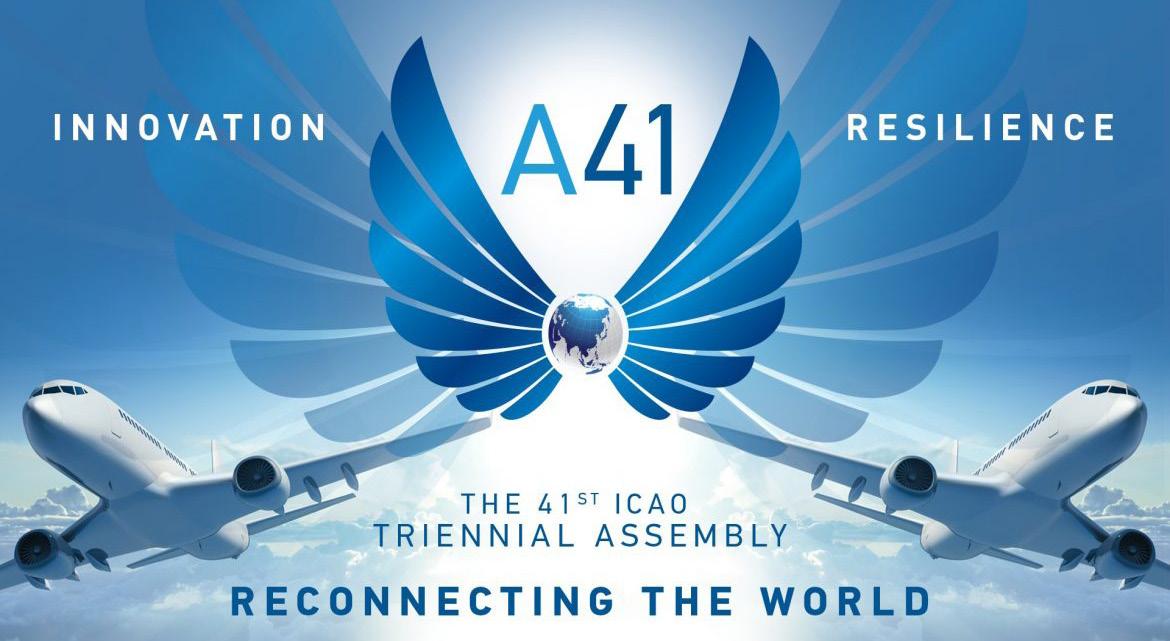
feeling of being heard and considered. That was my intention when I accepted this nomination, and I will let history tell the story of how that went.
I am indeed a proud African and South African and I bring unique offerings, motivated by many experiences I have had as an individual, which I believe many who had faith in me were drawn to. I will never denounce nor be bothered by my identity as an African and my gender to feed a narrative that this was a chance appointment. It was an appropriate appointment that was long overdue, because many women in civil aviation are capable of performing it.
GL: Does the focus on your being an African woman bother you? – Would you not prefer to be judged just as a person?
PK: On the contrary, I did not feel at all that I was judged by Member States as being an African woman. I am certain that if it bothered them, I would not have been elected.
What was celebrated is the appreciation for the leadership of the President of the Assembly, for the successful outcomes of the Assembly.
There was a broad consensus that this global meeting was cited as the most difficult, with the most contentious matters. In the end, the parties walked away with the
GL: And finally, does your appointment mean that you will be spending more time in Montreal and less time on SACAA business? How does your family feel about this? How do you juggle your very demanding work schedule and family?
The President of the Assembly position is only valid for the duration of each Assembly and is not a fulltime appointment that will require me to spend more time in Montreal. It is different to the President of the Council, who gets appointed for a three-year term. I will be based in South Africa and continue with my duties at home.
While you have been grounded the other airlines have moved into your markets – particularly the regional and long-haul routes. Furthermore, it has been said that SAA cannot make money on longhaul flying east of Dubai. Are these some of the reasons you have been very cautious about getting back into long-haul flying?
The market has changed drastically post-Covid. As you know, this industry goes in global cycles and we are in a downturn and it will take years to start rising again. Right now longhaul is very risky. We will however be restarting longhaul in the first quarter of next year with our first carefully selected route.
An executive decision has been made to dispose of the A340 and replace it with equipment specifically chosen to best service longhaul routes. Our plan next year is to quickly ramp up to a total of 12 aircraft. And within that 12 we will have 9 A320s and 3 A330s. There’s currently some debate within the company as to whether to go with A330-200 or 300. Perhaps we will do an A350-900, depending on which the next longhaul route we choose to operate is. Perth will require an A350.
Let’s talk about your fleet – and whether it is fit for purpose. You only have two widebody longhaul aircraft left, an uncompetitive A340-600, and an A330-300. Is that sufficient to resume a longhaul flying?
You have been good at getting your old A320s back, even with their original SAA liveries and seating configurations. Is there any chance you can get any of the A350s back?
The team is looking at that but it's a bit difficult as those aircraft were leased and the lessors were prejudiced in the business recovery. But in terms of recovering our former aircraft, we are not going out to get them, the lessors are approaching us.
So despite the business rescue process, it looks as though the lessors are still quite keen to do business with SAA?
They are indeed and it has been encouraging. The widebody market has had a slow trajectory of recovery, but the narrow body has been buoyant. Do you have a clear fleet renewal strategy at this stage?
Our fleet renewal strategy goes beyond what we had expected. First of all, we are into existing fleet extension rather than purchasing new aircraft. New aircraft acquisition will be determined by how the transaction with the strategic equity partner (SEP) concludes as that transaction has a very robust business plan. If the SEP transaction gets delayed beyond which we as the board of SAA
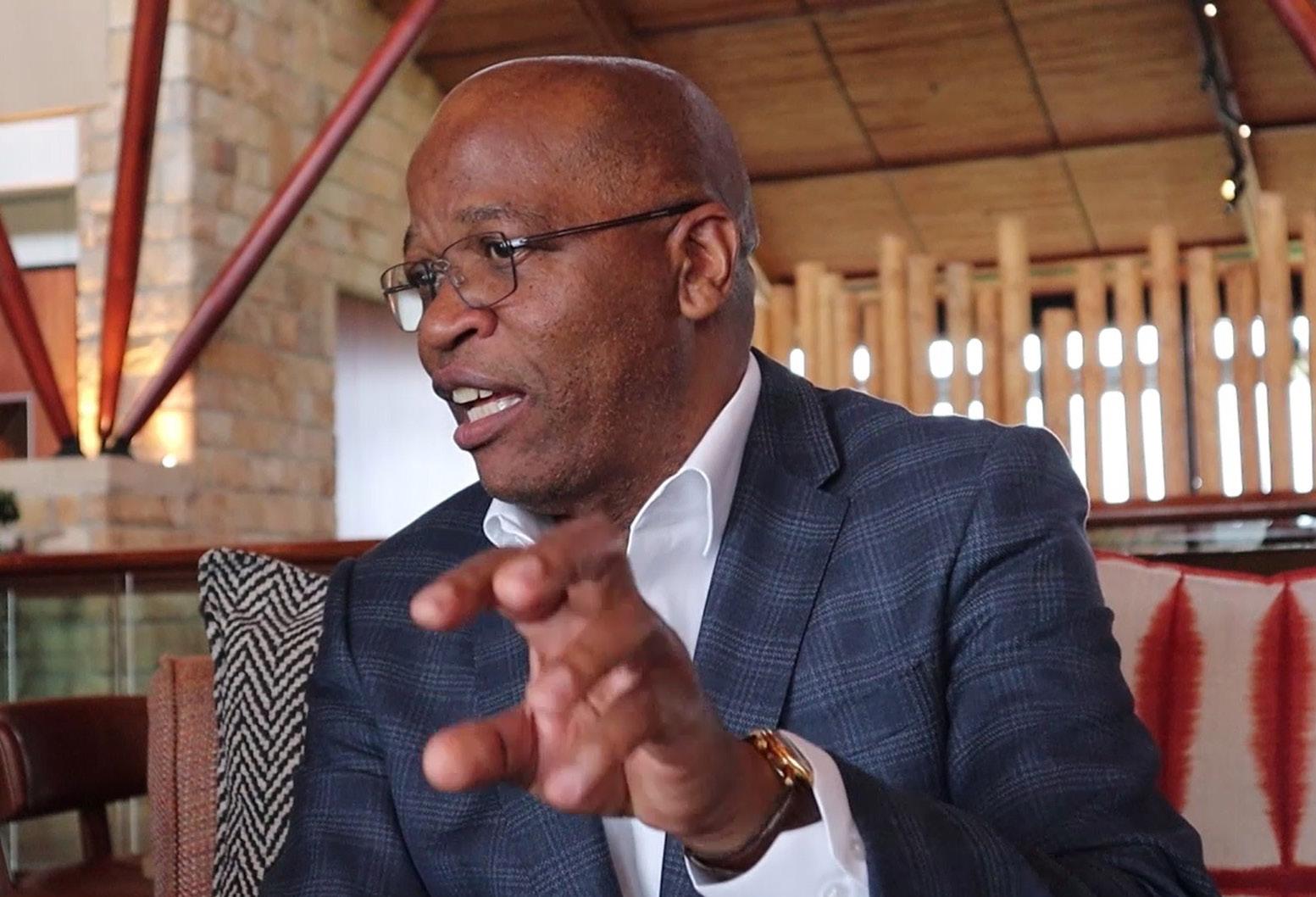
believe is healthy, then we will start implementing that business plan ourselves. Moving on to your financial position - SAA is currently configured to be quite a lot bigger than it currently is in terms of your overhead structure and resources. Is it safe to assume that you are currently burning cash?
No. I can tell you confidently that since June we have had a positive cash flow, and it's growing beyond our expectations. When SAA came out of business rescue the business plan provided for R2 billion worth of working capital. We have been flying since May last year so we have been running for 18 months. If we were really losing money, we could not have run for 18 months on R2 billion.
The SEP is scheduled for completion by the end of March next year which would seem to be extremely unlikely. Can you survive at least until then?
We have done far more than was expected: the receivership provided for R3.5 million billion worth of a debt which we're supposed to pay back in three tranches. Government has not provided that money. But two of those tranches have already been serviced by the airline out of operating capital. So the airline is doing well. Partially due to the fact that we went on a very aggressive drive to mobilise lazy cash within the business. Amongst these were the blocked funds held in companies like Angola, Zimbabwe and Burundi. There was more than a R1 billion out there due to us, and we have got in more than R500 million of that so far.
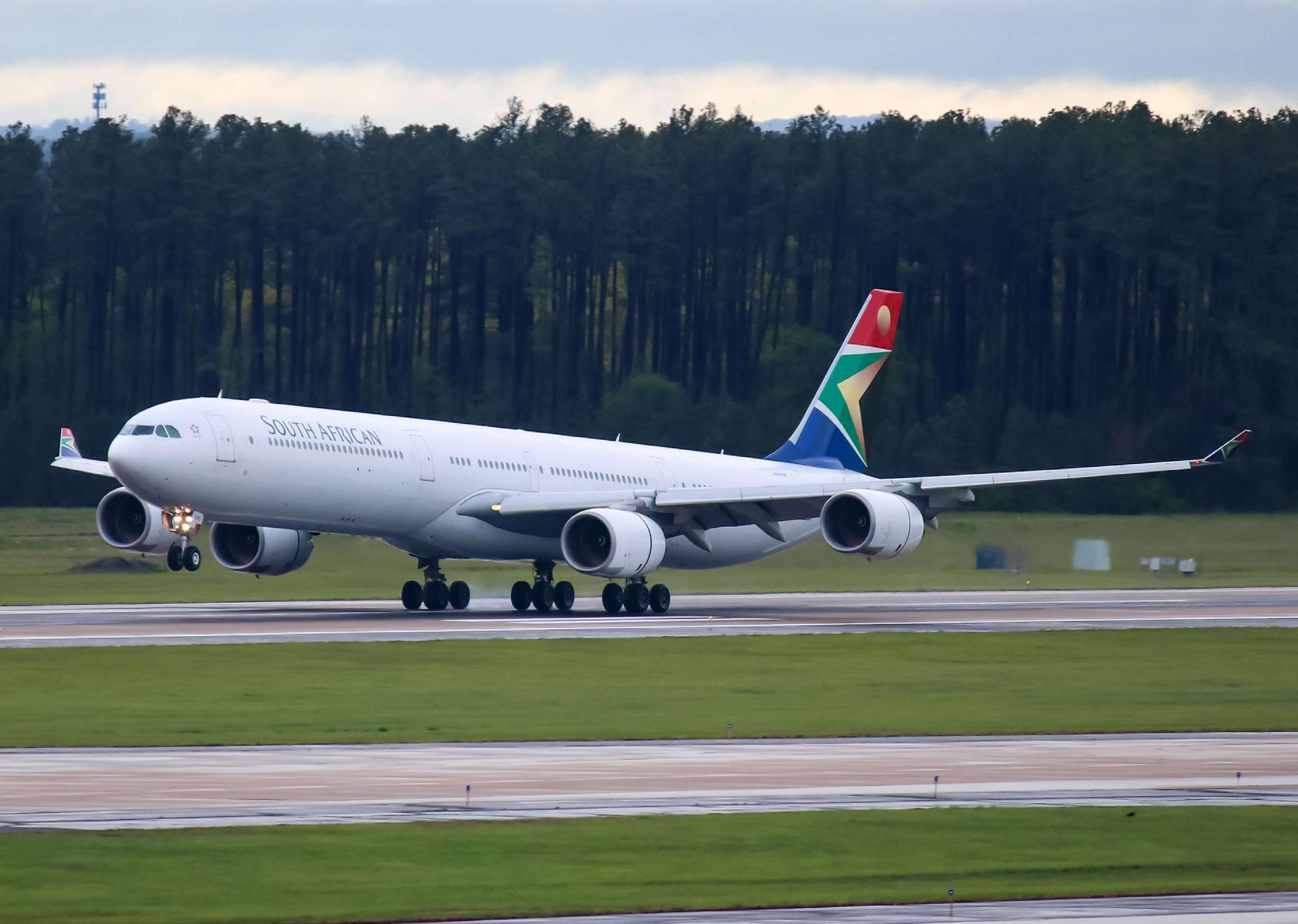
And finally, as the ‘flag carrier’ you still have to fulfil a development agenda. How do you balance that with the commercial imperative of being sustainable - if not profitable?
The two goals are really inseparable. SAA is a seedbed for those who would never otherwise have had a chance to become pilots or aviation managers. Of course, this comes with a price in that a lot of taxpayers’ money has had to be put into sustaining SAA. However, we are now in a different phase and we have learned much from the past. The challenge is now to balance the political and the commercial. There has been a major mind shift from the past to the current management of SAA.
AIR CARGO DEMAND SOFTENS

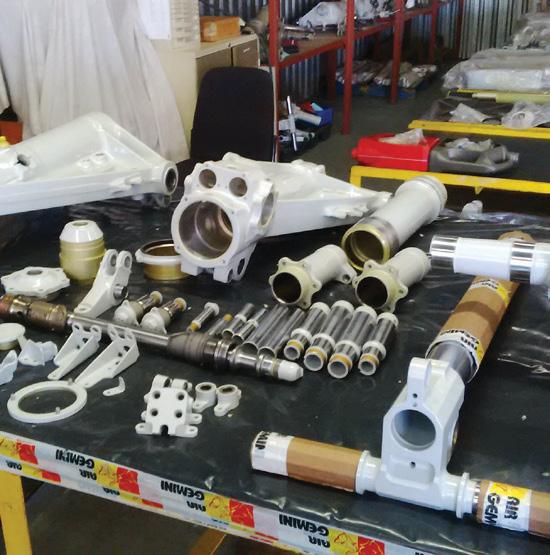

Global demand fell 10.6% compared to September 2021 (-10.6% also for international operations), but continued to track at near pre-pandemic levels (-3.6%). Capacity was 2.4% above September 2021 (+5.0% for international operations) but still 7.4% below September 2019 levels (-8.1% for international operations).
African airlines saw cargo volumes increase by 0.1% in September 2022 compared to September 2021.
This was a slight decrease in the growth recorded the previous month (1.0%). Capacity was 4.1% below September 2021 levels.
“While air cargo’s activity continues to track near to 2019 levels, volumes remain below 2021’s exceptional performance as the industry faces some headwinds. At the consumer level, with travel restrictions lifting postpandemic, people are likely to spend more on vacation travel and less on e-commerce,” said Willie Walsh, IATA’s Director General.
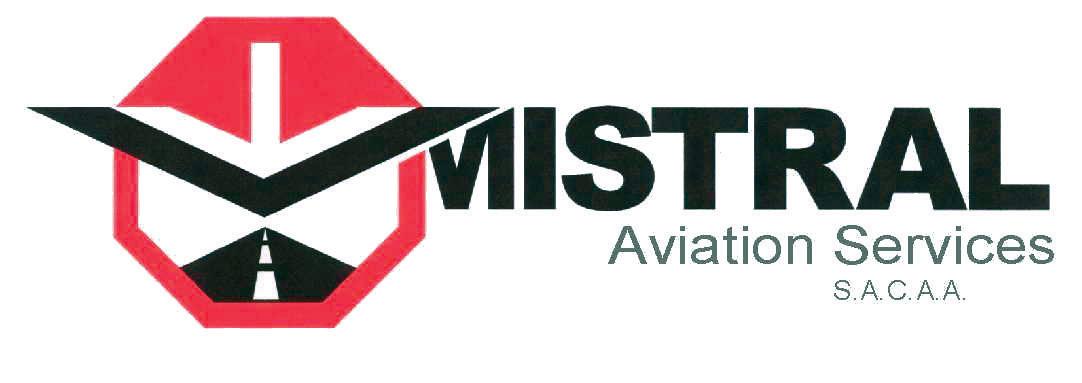
Space Weather has come to be an increasingly critical component of flight planning and dispatch.
Space weather refers to the conditions in space emanating from the sun, impacting on the performance and reliability of space-borne and ground-based technological systems such as communication, navigation and power grids. Industries such as aviation rely on communication and navigation capabilities to operate in a safe and compliant manner.
Early warnings and forecasts are crucial for protecting satellites, national power grids, communications and navigation systems from the harmful effects of solar storms and other space weather phenomena.
In November 2022 South Africa’s SANSA officially launched its huge investment in a key state of the art space weather facility.
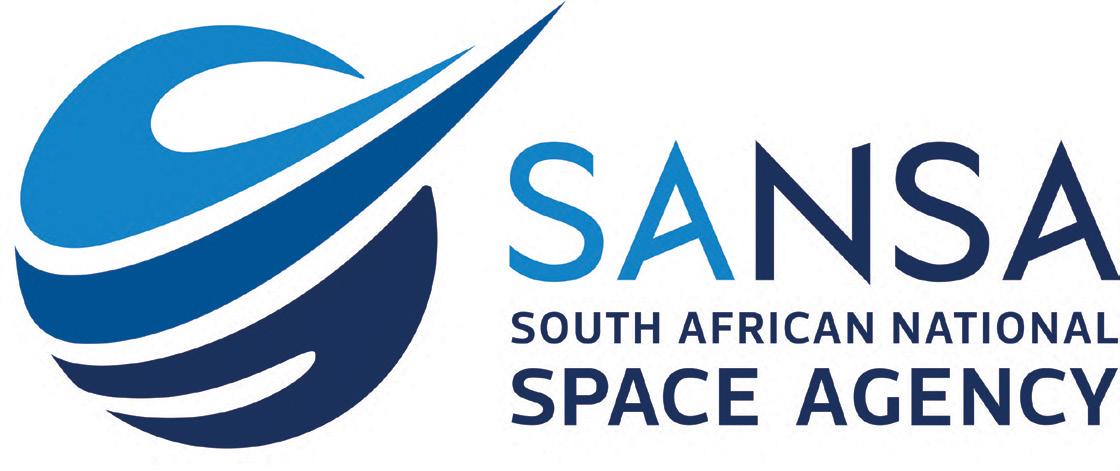
THE SOUTH AFRICAN National Space Agency (SANSA) has been operating a Space Weather Centre for the past 10 years in Hermanus in the Western Cape. It has worked on monitoring the sun and its activity, and providing space weather forecasts, warnings, alerts and environmental data on space weather conditions, all of which are critical to aviation safety.
Space weather can interfere with satellite electronics, communications and GPS signals, amongst other things. With the growing need to monitor space weather and its impact on communities and technology, SANSA has launched an operational 24/7 space weather capability and has been designated as a Regional Warning Centre for Africa.
SANSA has four strategic programmes – Space
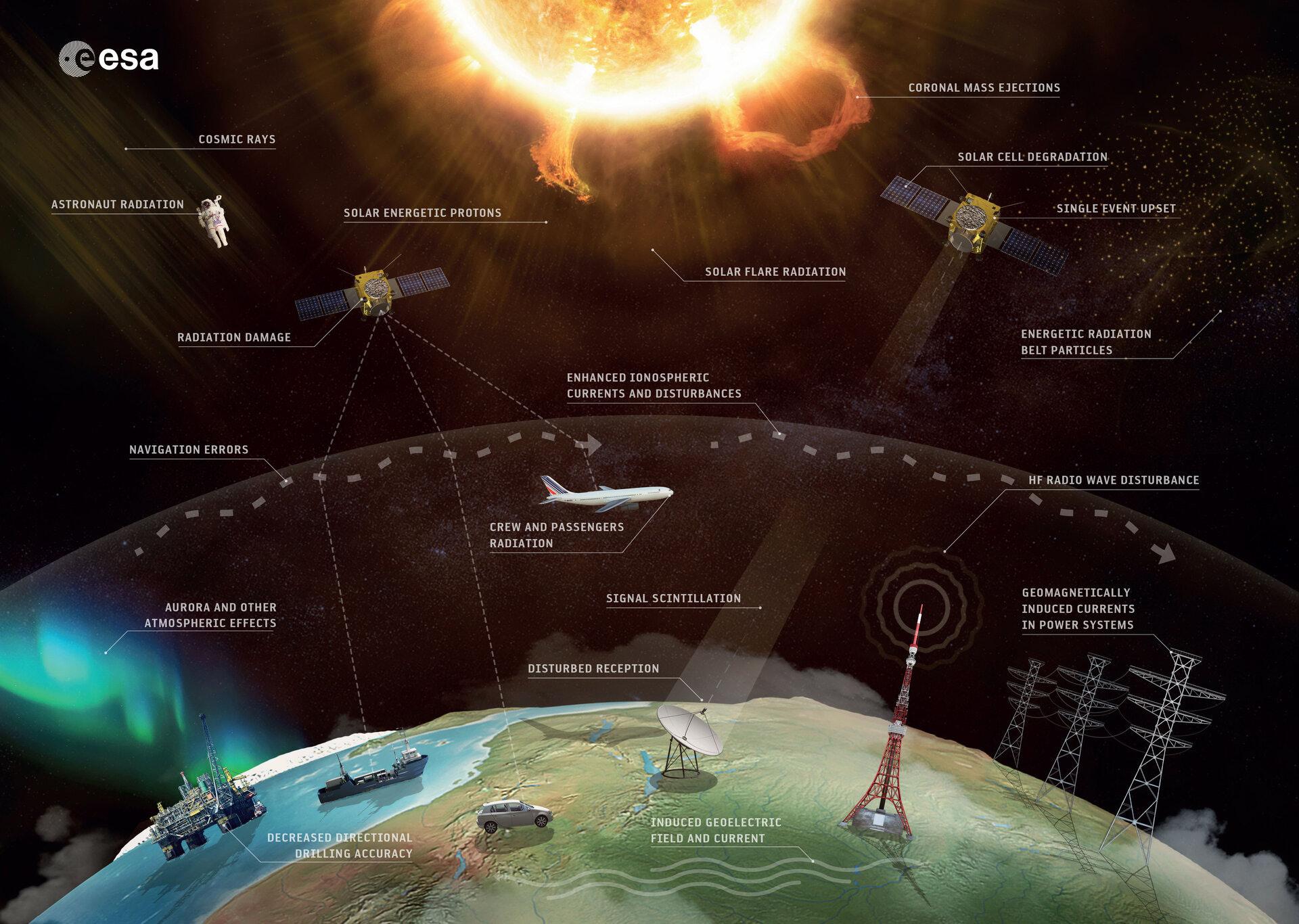
Space weather effects on aviation.
Science, Space Operations, Space Engineering and Earth Observation.
The Space Agency’s mandate is to provide for the promotion and use of space and co-operation in spacerelated activities, foster research in space science, advance scientific engineering, develop human capabilities in space science, and support the creation of an environment conducive to industrial development. This has direct benefits. For example, during the 2022 floods in KwaZulu Natal and the Jagersfontein mine waste dam collapse, SANSA provided satellite imagery to support the disaster response and for understanding the level of damage.
SANSA’s much enhanced space weather capability has been developed in response to the International Civil Aviation Organisation (ICAO) 2021 selection of SANSA as one of two ICAO-designated Regional Space Weather Centers.
The implications of this designation meant that a full operational capability that meets the ICAO requirements needed to be put in place by 2024 to provide advanced research capabilities in the space weather field. The regional centres provide space weather services, including solar storm forecasts and warnings to the global aviation sector.
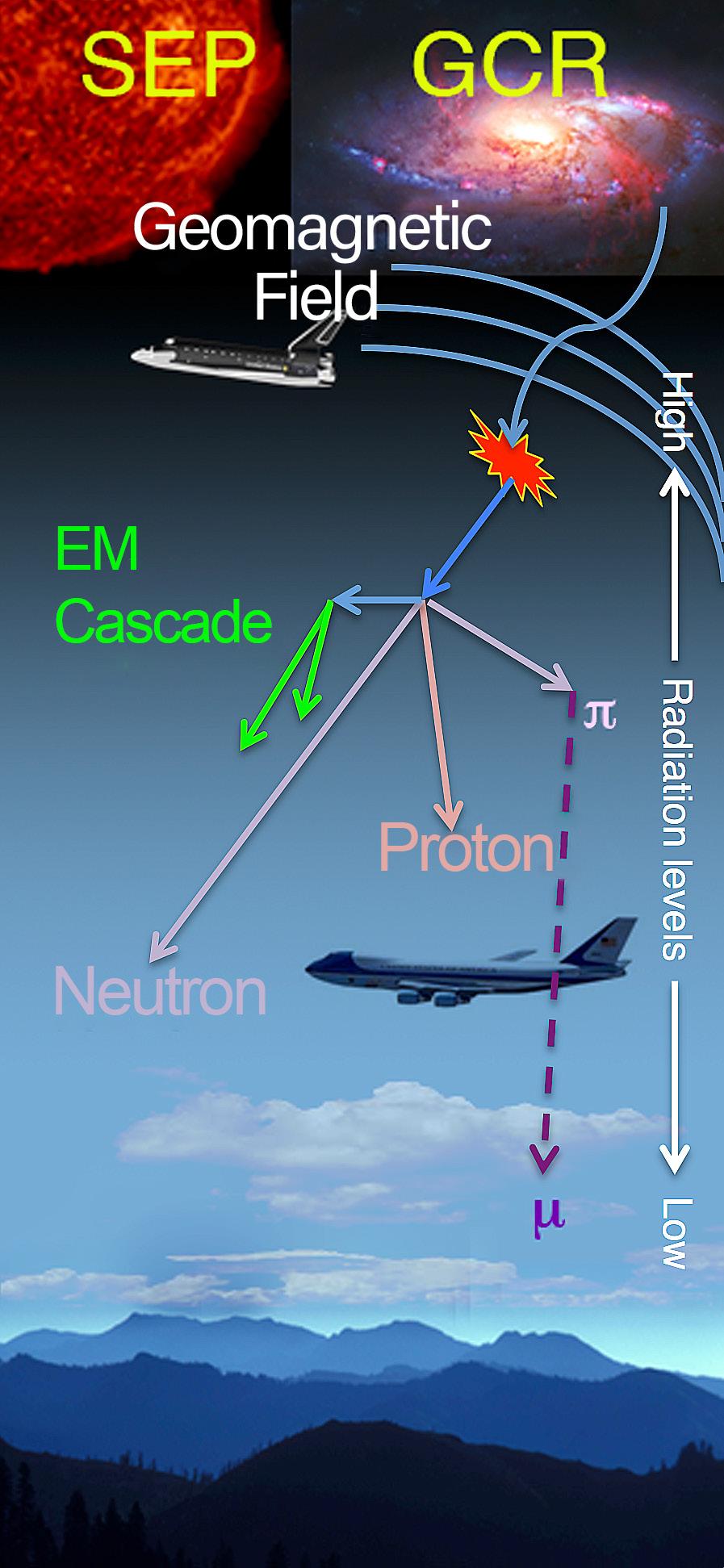
SANSA also has a role in international space cooperation, for example, the Agency is negotiating with NASA for the establishment of a tracking and telemetry station in Matjiesfontein in support of future lunar exploration on the Moon.

Science, technology, engineering and mathematics (STEM) are key developmental skills. To this end SANSA’s Science Centre in Hermanus hosts educator workshops to support STEM educators.
SANSA has also announced the establishment of the first SANSA Research Chair in Space Weather.
Space science is a global industry and SANSA has developed extensive partnerships with space agencies and organisations across the world through which it provides numerous opportunities for the local space industry and academia. SANSA partners with African countries to provide training in the application of space technologies and to create a network of scientific nodes for aligned research on the continent. The African Resource Management Constellation is one such initiative, which looks at African partners contributing a constellation of Earth observation satellites to allow Africa to manage more efficiently its natural resources and ensure food security while reducing costs and reliance on international satellite providers.
The space agency continues to implement activities targeting women in science and the previously disadvantaged youth. A key milestone in the Agency’s infrastructure development objectives is the establishment of a Space Infrastructure Hub (SIH). This hub will facilitate skills, capacity development, and job creation within the space industry;
SANSA is a key part of STEM education.
In 2019, the South African National Space Agency (SANSA) developed a business case for the establishment of an operational space weather services capability to forecast space weather on a 24/7 basis to mitigate the impact of space weather on technological systems.
The business case was approved and the establishment would take three years, building on the existing space weather research and development legacy in SANSA. This would include infrastructure development, instrumentation deployment, product and service development, and capability development through an investment in the required skills.
The project commenced in October 2019 and despite Covid, was completed on schedule and within budget by the end of September 2022.
The total investment in this capability amounts to ZAR 107.5 million over the three years which includes a ring-fenced establishment grant of ZAR 70.89 million received from the Department of Science and Innovation (DSI) plus R 36.6 million invested directly by SANSA in the Hermanus Facility and ICT infrastructure to ensure that the Space Weather Infrastructure could be supported on
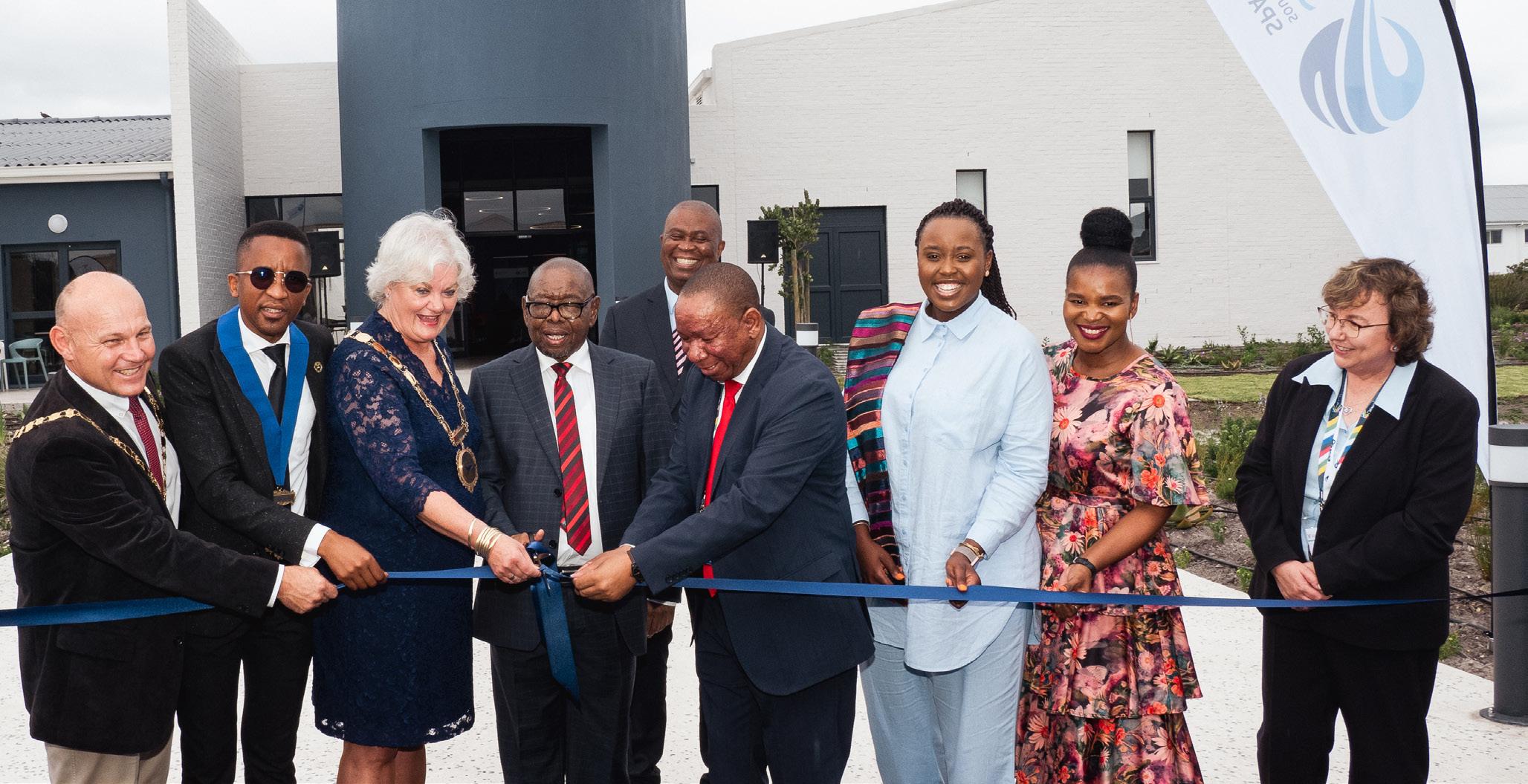
the existing SANSA campus. In addition, the DSI committed a SARCHI Research Chair in Space Weather to SANSA, which is assisting in filling expertise gaps.
SANSA says that, “The development of an Operational Space Weather Services Capability for the country is more than just the building of a new Space Weather Centre – it represents the value of science, technology, and innovation in building new applications and technologies, and in solving global challenges. The launch of this capability also provides SANSA and DSI with an opportunity to showcase the value of science, technology, and innovation within the country. This is an ideal example of the complete value chain of research to operations that can demonstrate economic and social benefits.
The launch of SANSA's new state of the art Space Weather Centre.
With the new facility, SANSA will be able to develop comprehensive expertise in space weather science and applications while providing cuttingedge services to commercial clients and development partners. This Centre is dedicated to growing the nation’s science, engineering, technology and innovation sectors, offering opportunities to develop scarce skills and increase national research output, while ensuring that usable products and services are generated for the safety of the nation and Africa at large.
The International Space Weather Camp (ISWC) provides an exceptional opportunity for students from South Africa, the USA, and Germany to learn about space weather, a relatively new and exciting field involving the study of the Sun. Specifically, its influence on space and the Earth’s upper atmosphere as well as the impacts of solar events on space and ground-based technological systems that modern society relies on daily.
The ISWC consists of a series of lectures, hands-on projects and other activities. The subject matter covers Space Weather, comprising cosmic ray particle transport theory, plasma physics, solar physics, heliospheric
physics, computer simulations for modelling and understanding local Space Weather, and the impact on Earth’s atmosphere, satellites, and space.
The ISWC offers students a great platform to interact and engage with students and researchers from around the world. During the Camp students will also get an opportunity to learn about historic and current developments of space activities in South Africa, Germany, and the USA.
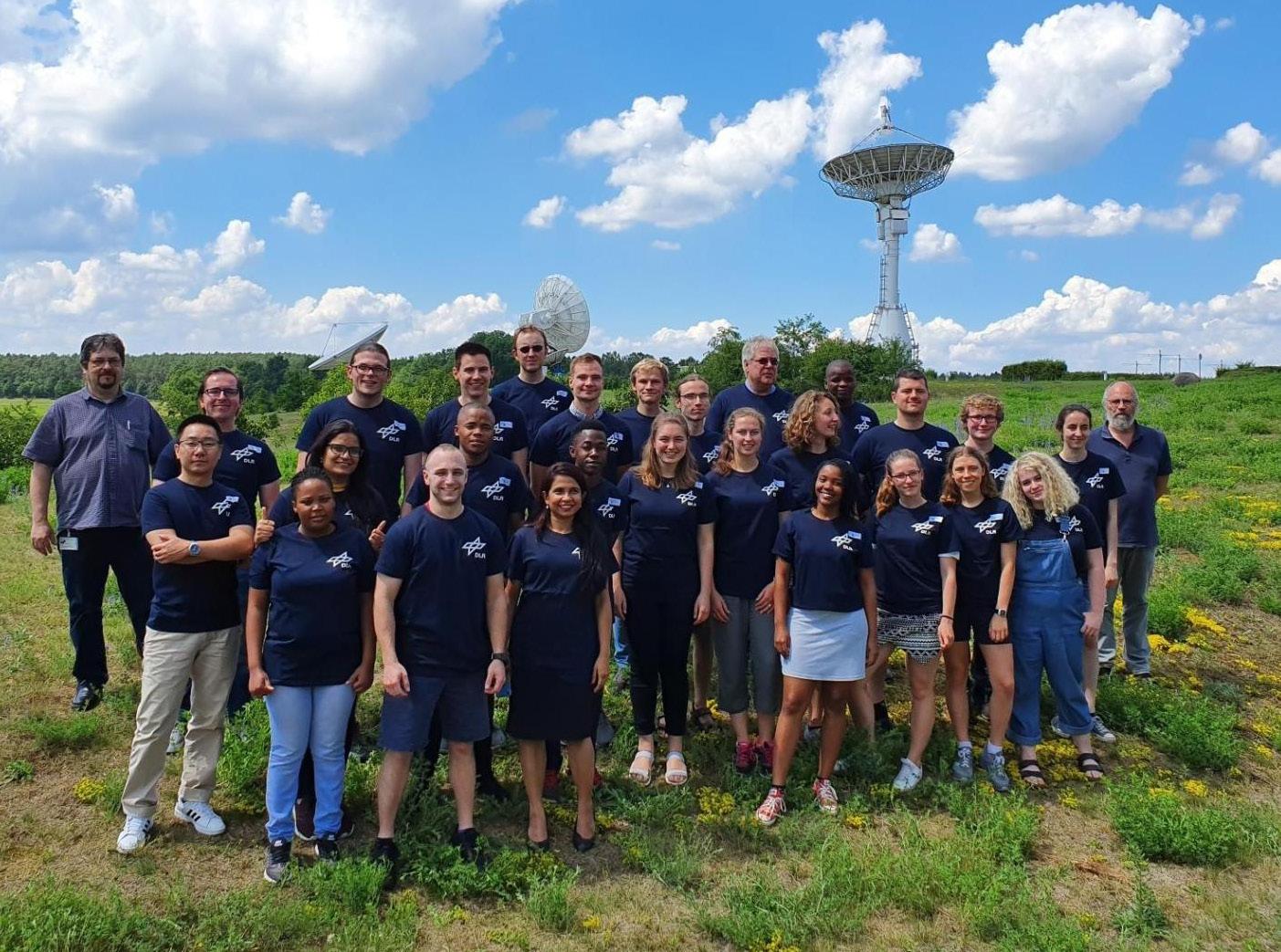
The ISWC will take place in two parts, with the first part taking place at the SANSA Hermanus facility from 24 June to 7 July 2023. The second part will be held in University of Alabama in Huntsville, USA from 8 to 23 July 2023. Successful applicants are expected to take part in both parts of the camp.
Details and applications for the camp can be found here: https://www.sansa.org.za/event/iswc/
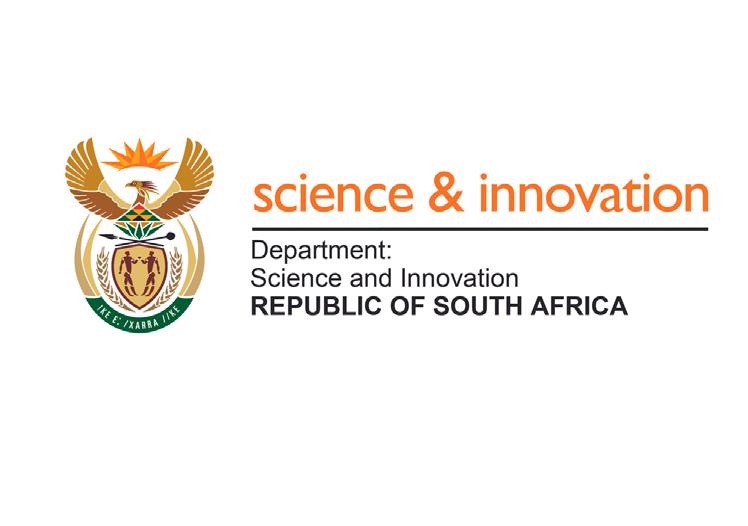
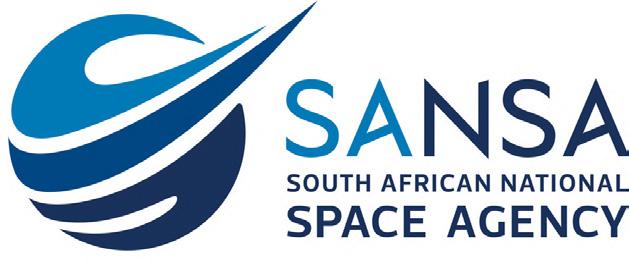
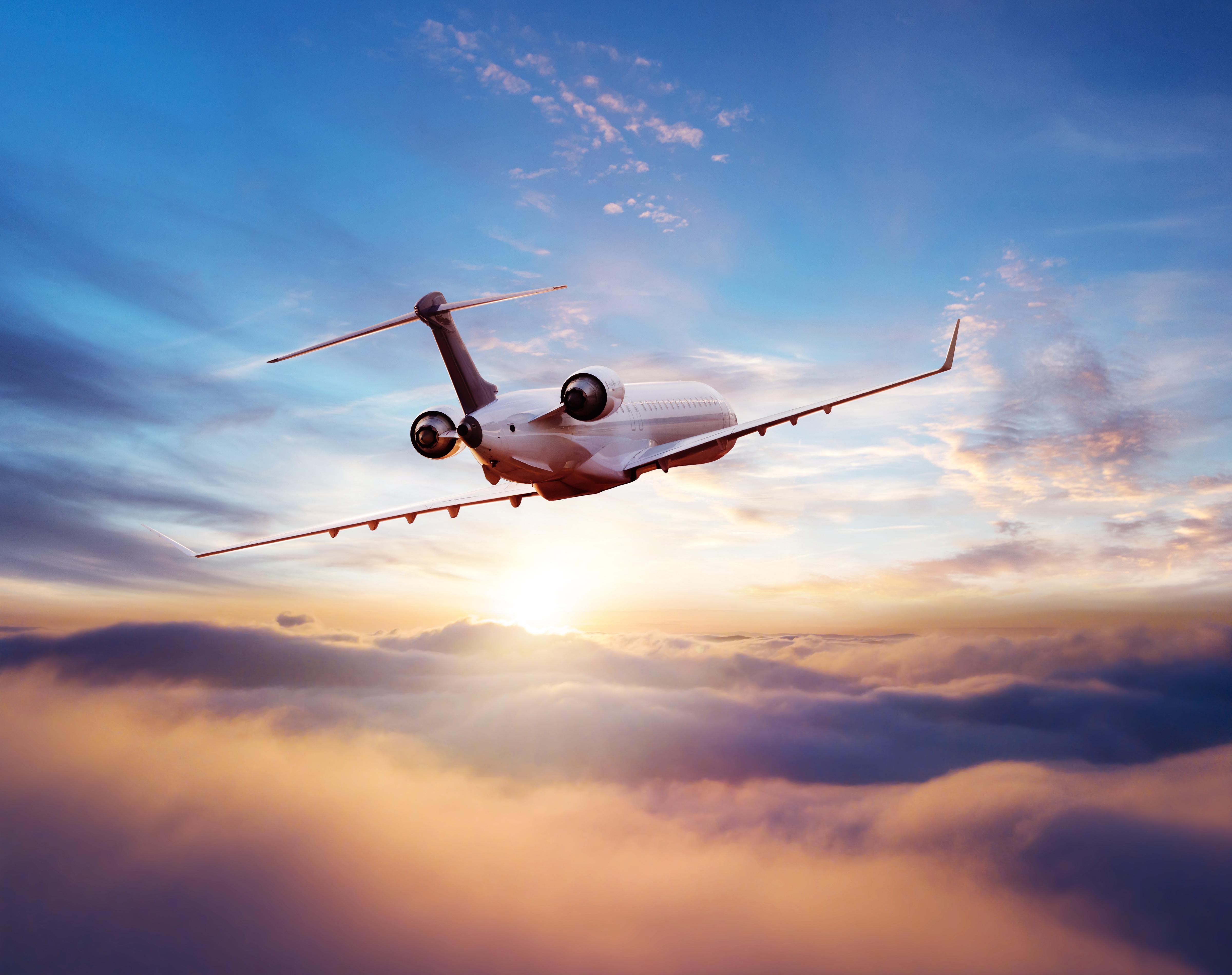






LANSERIA
ExecuJet South Africa (011) 516 2300 011 659 1071
Emperor Aviation (082) 497 1701
FLYONICS (Pty) Ltd (082) 686 2374 michael@flyonics.co.za
Heli-Afrique cc (011) 827 8632 086 503 1870
Placo (Pty) Ltd (011) 827 9301 827 3801
Alton Aero Engineering (035) 786 0146/7 786 0145

Legair Maintenance (083) 736 3969 086 508 6010
Aerocore (012) 110 4033 082 565 2330
Aircraft Maintenance @ Work Pty Ltd (012) 567 3443
Adventure Air (012) 543 3196 543 2323
Aerotric (087) 802 1347 aerotric@aol.com
Aero Engineering & Powerplant (012) 543 0948 543 9447
AviSys Aviation Systems (083) 442 5884 086 618 6996
APCO Pty Ltd (012) 543 0775 567 3630
AVIA Instruments (082) 464 7130 086 602 6171
Breytech Aviation cc (012) 567 3500 086 643 0122
A1A Flight Examiner (Loutzavia)
Jannie Loutzis 012 567 6775 / 082 416 4069 jannie@loutzavia.co.za www.loutzavia.co.za
Adventure Air Lande Milne 012 543 3196 / Cell: 066 4727 848 l.milne@venture-sa.co.za www.ventureglobal.biz
AES (Cape Town) Erwin Erasmus 082 494 3722 erwin@aeroelectrical.co.za www.aeroelectrical.co.za
AES (Johannesburg)
Danie van Wyk 011 701 3200 office@aeroelectrical.co.za www.aeroelectrical.co.za
Aerocore Jacques Podde 082 565 2330 jacques@aerocore.co.za www.aerocore.co.za
Aero Engineering & PowerPlant Andre Labuschagne 012 543 0948 aeroeng@iafrica.com
Aero Services (Pty) Ltd Chris Scott 011 395 3587 chris@aeroservices.co.za www.aeroservices.co.za
Aeronav Academy Donald O’Connor 011 701 3862 info@aeronav.co.za www.aeronav.co.za
Aeronautical Aviation Clinton Carroll 011 659 1033 / 083 459 6279 clinton@aeronautical.co.za www.aeronautical.co.za
Aerotric (Pty) Ltd Richard Small 083 488 4535 aerotric@aol.com
Aircraft Assembly and Upholstery Centre Tony/Siggi Bailes 082 552 6467 anthony@rvaircraft.co.za www.rvaircraft.co.za
Aircraft Finance Corporation & Leasing Jaco Pietersen +27 [0]82 672 2262 jaco@airfincorp.co.za Jason Seymour +27 [0]82 326 0147 jason@airfincorp.co.za www.airfincorp.co.za
Aircraft General Spares Eric or Hayley 084 587 6414 or 067 154 2147 eric@acgs.co.za or hayley@acgs.co.za www.acgs.co.za
Aircraft Maintenance @ Work Opelo / Frik 012 567 3443 frik@aviationatwork.co.za_ opelonke@aviationatwork.co.za
Aircraft Maintenance International Pine Pienaar 083 305 0605 gm@aminternational.co.za
Aircraft Maintenance International Wonderboom Thomas Nel 082 444 7996 admin@aminternational.co.za
Air Line Pilots’ Association Sonia Ferreira 011 394 5310 alpagm@iafrica.com www.alpa.co.za
Airshift Aircraft Sales Eugene du Plessis 082 800 3094 eugene@airshift.co.za www.airshift.co.za
Airvan Africa Patrick Hanly 082 565 8864 airvan@border.co.za www.airvan.co.za
Algoa Flying Club Sharon Mugridge 041 581 3274 info@algoafc.co.za www.algoafc.co.za
Alpi Aviation SA Dale De Klerk 082 556 3592 dale@alpiaviation.co.za www.alpiaviation.co.za
Apco (Ptyd) Ltd Tony/Henk + 27 12 543 0775 apcosupport@mweb.co.za www.apcosa.co.za
Aref Avionics Hannes Roodt 082 462 2724 arefavionics@border.co.za
Atlas Aviation Lubricants Steve Cloete 011 917 4220 Fax: 011 917 2100 sales.aviation@atlasoil.co.za www.atlasaviation.co.za
ATNS Percy Morokane 011 607 1234 percymo@atns.co.za www.atns.com
Aviation Direct Andrea Antel 011 465 2669 info@aviationdirect.co.za www.aviationdirect.co.za
BAC Aviation AMO 115 Micky Joss 035 797 3610 monicad@bacmaintenance.co.za
Blackhawk Africa Cisca de Lange 083 514 8532 cisca@blackhawk.aero www.blackhawk.aero
Blue Chip Flight School Henk Kraaij 012 543 3050 bluechip@bluechip-avia.co.za www.bluechipflightschool.co.za
Border Aviation Club & Flight School Liz Gous 043 736 6181 admin@borderaviation.co.za www.borderaviation.co.za
Breytech Aviation cc 012 567 3139 Willie Breytenbach admin@breytech.co.za
Bundu Aviation Phillip Cronje 083 485 2427 info@bunduaviation.co.za www.bunduaviation.co.za
Celeste Sani Pak & Inflight Products
Steve Harris 011 452 2456 admin@chemline.co.za www.chemline.co.za
Cape Aircraft Interiors Sarel Schutte 021 934 9499 michael@wcaeromarine.co.za www.zscai.co.za
Cape Town Flying Club Beverley Combrink 021 934 0257 / 082 821 9013 info@capetownflyingclub.co.za www.@capetownflyingclub.co.za
Century Avionics cc Carin van Zyl 011 701 3244 sales@centuryavionics.co.za www.centuryavionics.co.za
Chemetall Wayne Claassens 011 914 2500 wayne.claassens@basf.com www.chemetall.com
Chem-Line Aviation & Celeste Products Steve Harris 011 452 2456 sales@chemline.co.za www.chemline.co.za
Comporob Composite Repair & Manufacture Felix Robertson 072 940 4447 083 265 3602 comporob@lantic.net www.comporob.co.za
Corporate-Aviators/Affordable Jet Sales Mike Helm 082 442 6239 corporate-aviators@iafrica.com www.corporate-aviators.com
C. W. Price & Co Kelvin L. Price 011 805 4720 cwp@cwprice.co.za www.cwprice.co.za
Dart Aeronautical Jaco Kelly 011 827 8204 dartaero@mweb.co.za
Dart Aircraft Electrical Mathew Joubert 011 827 0371 Dartaircraftelectrical@gmail.com www.dartaero.co.za
DJA Aviation Insurance 011 463 5550 0800Flying mail@dja-aviation.co.za www.dja-aviation.co.za
Dynamic Propellers Andries Visser 011 824 5057 082 445 4496 andries@dynamicpropeller.co.za www.dynamicpropellers.co.za
Eagle Aviation Helicopter Division Tamryn van Staden 082 657 6414 tamryn@eaglehelicopter.co.za www.eaglehelicopter.co.za
Eagle Flight Academy Mr D. J. Lubbe 082 557 6429 training@eagleflight.co.za www.eagleflight.co.za
Elite Aviation Academy Jacques Podde 082 565 2330 info@eliteaa.co.za www.eliteaa.co.za
Enstrom/MD Helicopters Andrew Widdall 011 397 6260 aerosa@safomar.co.za www.safomar.co.za
Era Flug Flight Training Pierre Le Riche 021 934 7431 info@era-flug.com www.era-flug.com
Execujet Africa 011 516 2300 enquiries@execujet.co.za www.execujet.com
Federal Air Rachel Muir 011 395 9000 shuttle@fedair.com www.fedair.com
Ferry Flights int.inc. Michael (Mick) Schittenhelm 082 442 6239 ferryflights@ferry-flights.com www.ferry-flights.com
Fireblade Aviation 010 595 3920 info@firebladeaviation.com www.firebladeaviation.com
Flight Training College Cornell Morton 044 876 9055 ftc@flighttrainning.co.za www.flighttraining.co.za
Flight Training Services
Amanda Pearce 011 805 9015/6 amanda@fts.co.za www.fts.co.za
Fly Jetstream Aviation Henk Kraaij 083 279 7853 charter@flyjetstream.co.za www.flyjetstream.co.za
Flying Frontiers Craig Lang 082 459 0760
CraigL@fairfield.co.za www.flyingfrontiers.com
Flying Unlimited Flight School (Pty) Ltd Riaan Struwig 082 653 7504 / 086 770 8376 riaan@ppg.co.za www.ppg.co.za
Foster Aero International Dudley Foster 011 659 2533 info@fosteraero.co.za www.fosteraero.co.za
Gemair Andries Venter 011 701 2653 / 082 905 5760 andries@gemair.co.za
GIB Aviation Insurance Brokers Richard Turner 011 483 1212 aviation@gib.co.za www.gib.co.za
Guardian Air 011 701 3011 082 521 2394 ops@guardianair.co.za www.guardianair.co.za
Heli-Afrique cc Tino Conceicao 083 458 2172 tino.conceicao@heli-afrique.co.za
Henley Air Andre Coetzee 011 827 5503 andre@henleyair.co.za www.henleyair.co.za
Hover Dynamics Phillip Cope 074 231 2964 info@hover.co.za www.hover.co.za
Indigo Helicopters Gerhard Kleynhans 082 927 4031 / 086 528 4234 veroeschka@indigohelicopters.co.za www.indigohelicopters.co.za
IndigoSat South Africa - Aircraft Tracking Gareth Willers 08600 22 121 sales@indigosat.co.za www.indigosat.co.za
Integrated Avionic Solutions Gert van Niekerk 082 831 5032 gert@iasafrica.co.za www.iasafrica.co.za
International Flight Clearances Steve Wright 076 983 1089 (24 Hrs) flightops@flyifc.co.za www.flyifc.co.za
Investment Aircraft Quinton Warne 082 806 5193 aviation@lantic.net www.investmentaircraft.com
Jabiru Aircraft Len Alford 044 876 9991 / 044 876 9993 info@jabiru.co.za www.jabiru.co.za
Jim Davis Books Jim Davis 072 188 6484 jim@border.co.za www.jimdavis.co.za
Joc Air T/A The Propeller Shop Aiden O’Mahony 011 701 3114 jocprop@iafrica.com
Kishugu Aviation +27 13 741 6400 comms@kishugu.com www.kishugu.com/kishugu-aviation
Kit Planes for Africa
Stefan Coetzee 013 793 7013 info@saplanes.co.za www.saplanes.co.za
Kzn Aviation (Pty) Ltd Melanie Jordaan 031 564 6215 mel@kznaviation.co.za www.kznaviation.co.za
Lanseria Aircraft Interiors
Francois Denton 011 659 1962 / 076 810 9751 francois@aircraftcompletions.co.za
Lanseria International Airport Mike Christoph 011 367 0300 mikec@lanseria.co.za www.lanseria.co.za
Legend Sky 083 860 5225 / 086 600 7285 info@legendssky.co.za www.legendsky.co.za
Litson & Associates (Pty) Ltd OGP, BARS, Resources Auditing & Aviation Training karen.litson@litson.co.za Phone: 27 (0) 21 8517187 www.litson.co.za
Litson & Associates Risk Management Services (Pty) Ltd. eSMS-S/eTENDER/ eREPORT/Advisory Serviceskaren.litson@litson.co.za Phone: 27 (0) 8517187 www.litson.co.za
Loutzavia Aircraft Sales Henry Miles 082 966 0911 henry@loutzavia.co.za www.loutzavia.co.za
Loutzavia Flight Training Gerhardt Botha 012 567 6775 ops@loutzavia.co.za www.loutzavia.co.za
Loutzavia-Pilots and Planes Maria Loutzis 012 567 6775 maria@loutzavia.co.za www.pilotsnplanes.co.za
Loutzavia Rand Frans Pretorius 011 824 3804 rand@loutzavia.co.za www@loutzavia.co.za
Lowveld Aero Club Pugs Steyn 013 741 3636 Flynow@lac.co.za Marshall Eagle Les Lebenon 011 958 1567 les@marshalleagle.co.za www.marshalleagle.co.za
Maverick Air Charters Chad Clark 083 292 2270 Charters@maverickair.co.za www.maverickair.co.za
MCC Aviation Pty Ltd
Claude Oberholzer 011 701 2332 info@flymcc.co.za www.flymcc.co.za
MH Aviation Services (Pty) Ltd Marc Pienaar 011 609 0123 / 082 940 5437 customerrelations@mhaviation.co.za www.mhaviation.co.za
M and N Acoustic Services cc Martin de Beer 012 689 2007/8 calservice@mweb.co.za
Metropolitan Aviation (Pty) Ltd Gert Mouton 082 458 3736 herenbus@gmail.com
Money Aviation Angus Money 083 263 2934 angus@moneyaviation.co.za www.moneyaviation.co.za
MS Aviation Gary Templeton 082 563 9639 gary.templeton@msaviation.co.za www.msaviation.co.za
North East Avionics Keith Robertson +27 13 741 2986 keith@northeastavionics.co.za deborah@northeastavionics.co.za www.northeastavionics.co.za
Orsmond Aviation 058 303 5261 info@orsmondaviation.co.za www.orsmondaviation.co.za
Owenair (Pty) Ltd Clive Skinner 082 923 9580 clive.skinner@owenair.co.za www.owenwair.co.za
Pacair Wayne Bond 033 386 6027 pacair@telkomsa.net
PFERD-South Africa (Pty) Ltd Hannes Nortman 011 230 4000 hannes.nortman@pferd.co.za www.pferd.com
Pipistrel Kobus Nel 083 231 4296 kobus@pipistrelsa.co.za www.pipistrelsa.co.za
Plane Maintenance Facility Johan 083 300 3619 pmf@myconnection.co.za
Precision Aviation Services Marnix Hulleman 012 543 0371 marnix@pasaviation.co.za www.pasaviation.co.za
PSG Aviation Reon Wiese 0861 284 284 reon.wiese@psg.co.za www.psg aviation.co.za
Rainbow SkyReach (Pty) Ltd Mike Gill 011 817 2298 Mike@fly-skyreach.com www.fly-skyreach.com
Rand Airport Stuart Coetzee 011 827 8884 stuart@randairport.co.za www.randairport.co.za
Robin Coss Aviation Robin Coss 021 934 7498 info@cossaviation.com www.cossaviation.co.za
SAA Technical (SOC) Ltd SAAT Marketing 011 978 9993 satmarketing@flysaa.com www.flysaa.com/technical
SABRE Aircraft Richard Stubbs 083 655 0355 richardstubbs@mweb.co.za www.aircraftafrica.co.za
SA Mooney Patrick Hanly 082 565 8864 samooney@border.co.za www.samooney.co.za
Savannah Helicopters De 082Jager 444 1138 / 044 873 3288 dejager@savannahhelicopters.co.za www.savannahhelicopters.co.za
Scenic Air Christa van Wyk +264 612 492 68 windhoek@scenic-air.com www.scenic-air.com
Sheltam Aviation Durban Susan Ryan 083 505 4882 susanryan@sheltam.com www.sheltamaviation.com
Sheltam Aviation PE Brendan Booker 082 497 6565 brendanb@sheltam.com www.sheltamaviation.com
Sky-Tech Heinz Van Staden 082 720 5210 sky-tech@telkomsa.net www.sky-tech.za.com
Sling Aircraft Kim Bell-Cross 011 948 9898 sales@airplanefactory.co.za www.airplanefactory.co.za
Solenta Aviation (Pty Ltd) Paul Hurst 011 707 4000 info@solenta.com www.solenta.com
Southern Energy Company (Pty) Ltd Elke Bertram +264 8114 29958 johnnym@sec.com.na www.sec.com.na
Southern Rotorcraft cc Mr Reg Denysschen Tel no: 0219350980 sasales@rotors-r-us.com www.rotors-r-us.com
Starlite Aero Sales Klara Fouché +27 83 324 8530 / +27 31 571 6600 klaraf@starliteaviation.com www.starliteaviation.com
Starlite Aviation Operations Trisha Andhee +27 82 660 3018/ +27 31 571 6600 trishaa@starliteaviation.com www.starliteaviation.com
Starlite Aviation Training Academy Durban: +27 31 571 6600 Mossel Bay: +27 44 692 0006 train@starliteaviation.com www.starliteaviation.com
Status Aviation (Pty) Ltd Richard Donian 074 587 5978 / 086 673 5266 info@statusaviation.co.za www.statusaviation.co.za
Superior Pilot Services Liana Jansen van 0118050605/2247Rensburg info@superiorair.co.za www.superiorair.co.za
The Copter Shop Bill Olmsted 082 454 8555 execheli@iafrica.com www.execheli.wixsite.com/the-coptershop-sa
Titan Helicopter Group 044 878 0453 info@titanhelicopters.com www.titanhelicopters.com TPSC Dennis Byrne 011 701 3210 turboprop@wol.co.za
Trio Helicopters & Aviation cc CR Botha or FJ Grobbelaar 011 659 1022 stoffel@trioavi.co.za/frans@trioavi.co.za www.trioavi.co.za
Tshukudu Trailers Pieter Visser 083 512 2342 deb@tshukudutrailers.co.za www.tshukudutrailers.co.za
U Fly Training Academy Nikola Puhaca 011 824 0680 ufly@telkomsa.net www.uflyacademy.co.za
United Charter cc Jonathan Wolpe 083 270 8886 jonathan.wolpe@unitedcharter.co.za www.unitedcharter.co.za
United Flight Support
Clinton Moodley/Jonathan Wolpe 076 813 7754 / 011 788 0813 ops@unitedflightsupported.com www.unitedflightsupport.com
Unique Air Charter
Nico Pienaar 082 444 7994 nico@uniqueair.co.za www.uniqueair.co.za
Unique Flight Academy
Nico Pienaar 082 444 7994 nico@uniqueair.co.za www.uniqueair.co.za
Van Zyl Aviation Services Colette van Zyl 012 997 6714 admin@vanzylaviationco.za www.vanzylaviation.co.za
Vector Aerospace Jeff Poirier +902 888 1808 jeff.poirier@vectoraerospace.com www.vectoraerospace.com
Velocity Aviation Collin Pearson 011 659 2306 / 011 659 2334 collin@velocityaviation.co.za www.velocityaviation.co.za
Villa San Giovanni Luca Maiorana 012 111 8888 info@vsg.co.za www.vsg.co.za
Vortx Aviation Bredell Roux 072 480 0359 info@vortx.co.za www.vortxaviation.com
Wanafly Adrian Barry 082 493 9101 adrian@wanafly.net www.wanafly.co.za
Windhoek Flight Training Centre Thinus Dreyer 0026 40 811284 180 pilots@flywftc.com www.flywftc.com
Wings n Things Wendy Thatcher 011 701 3209 wendy@wingsnthings.co.za www.wingsnthings.co.za
Witbank Flight School Andre De Villiers 083 604 1718 andredv@lantic.net www.waaflyingclub.co.za
Wonderboom Airport Peet van Rensburg 012 567 1188/9 peet@wonderboomairport.co.za www.wonderboomairport.co.za
Zandspruit Bush & Aero Estate Martin Den Dunnen 082 449 8895 martin@zandspruit.co.za www.zandspruit.co.za
Zebula Golf Estate & SPA Reservations 014 734 7700 reception@zebula.co.za www.zebula.co.za